Public Pier — No Fishing License Required
The date was August 25, 1966, just nine days before my bride and I would tie the knot. The plans were finished and hopefully everything was ready to go. It was time to relax and this would be a day for fishing, a passionate sport that my future wife Pat had already learned would be the “significant other” in our marriage.
It was my first visit to the Oceanside Pier and my hopes were high. Unfortunately, the fishing was slow, really slow, and I only caught one lone fish. Subsequent trips were much better but it showed that there is never a guarantee when it comes to fishing, success can ebb and flow and change with the years.
Oceanside too has seemed to ebb and flow over the years. In 1966 the town was a fairly inexpensive place to live and was certainly a “Marine town” with all the obligatory shops catering to the needs of young men lonely and perhaps a long way from home. At the time the main street through town reminded me of lower Broadway in San Diego with its shops that provided low cost rings, tattoos and other goodies for men in the Navy. It was the Vietnam era and a different time.
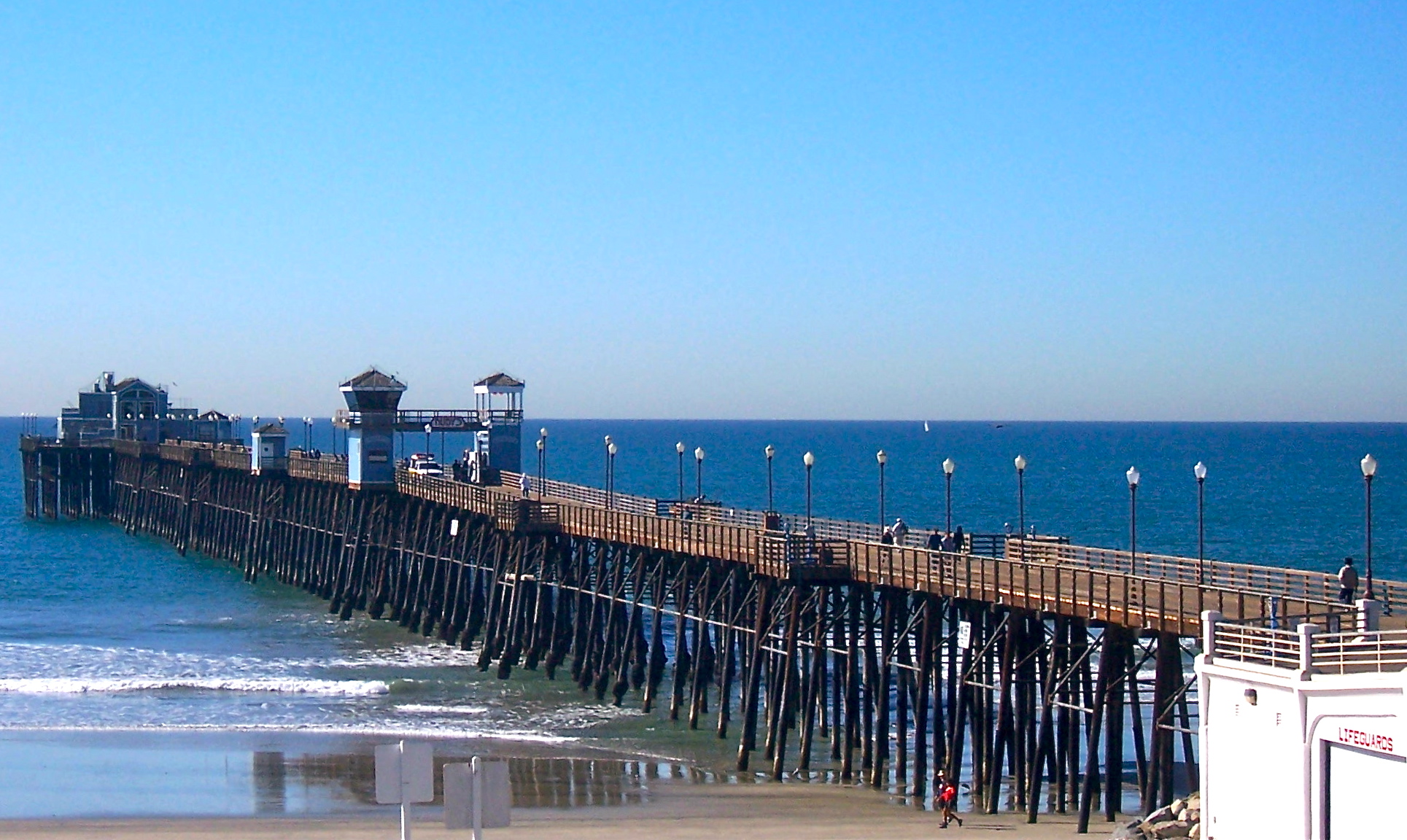
Today Oceanside is expensive, perhaps not as much as other “North County” towns to the south, but it’s getting there. Today the shoreline is becoming home to luxury hotels, nice places to stay but different from the cheap motels that once lined the old Pacific Coast Highway (PCH). Today the city seemingly wants to upgrade the image of Oceanside (as if it is really needed).
One thing that hasn’t changed is the importance of the Oceanside Pier to the city. In 1888 the city of Oceanside was officially incorporated and that same year a wharf company was formed. Money was raised, work began, and by late summer the wharf had reached 1,340 feet into the Pacific before the money, and the work, slowed. The wharf would be finished in 1889 but would simply be the first of Oceanside’s wharves/piers to suffer damage from storms and eventually be replaced. Time after time citizens recognized the importance of the pier, both in attracting tourists to Oceanside and in providing recreation for city residents, and time after time they voted to fix or rebuild the various piers. Today’s pier is the sixth pier and is as important as ever. A 2013 economic study for Oceanside found 74 percent of people visited the city because of the pier.
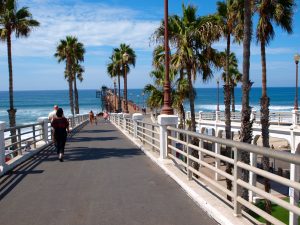
Hopefully the future will be bright. The pier is certainly one of the finest on the coast and one of the most visited. The pier itself is 1,942 feet long, which makes it the second longest wooden pier on the coast, exceeded only by the Ventura Pier at 1,958 feet in length (the Santa Cruz Wharf is 2,745 feet long but more of a commercial wharf than a pier mainly built for fishing).
It is also one of the most visited. A Fish and Game survey in 1990 listed the various piers and their annual attendance. The list was led by the big commercial wharves/piers that offer a plethora of commercial shops and restaurants—Redondo Beach at 4 million, the Santa Cruz Wharf at 3-4 million, Santa Monica at 2.5-3 million and Stearns Wharf in Santa Barbara at 1.6 million. The highest number seen at a fishing pier was Pismo Beach at 1.5 million. Oceanside was not listed due to the fact that the pier was under reconstruction when the survey was being done.
However, I have visited and fished every public pier in California multiple times and in my opinion none see the numbers of people that are seen at the Oceanside Pier. There may be times, usually during the winter months when fishing has slowed and the weather is iffy, when the crowds thin out. But visit the pier during the spring to fall months and it is often crowded from 6 A.M. until midnight (and later).
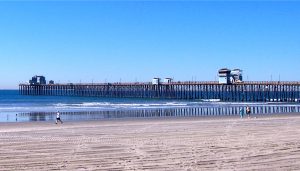
Of course the main attraction has always been the fishing. In fact, this was once considered a two-sack pier! That bit of knowledge was learned during a visit to the pier in July 1990. The story came from a regular, a gentleman of a youthful 78 years of age, and one who fished about 350 days a year. He said, “Back in the thirties you needed to bring two gunnysacks with you when you visited the pier because of the barracuda. Back then we called them logs, you know, big fish about 10 or 12 pounds each, and you could only get about five in a sack lengthwise. You fished until you loaded a couple of sacks then you stopped, no sense overdoing it. Of course you might need a little help carrying the sacks off the pier.” How accurate that memory was after more than fifty years can only be speculated. There is no doubt however, that fishing can be very good at Oceanside and that it probably was outstanding “back then.”
In fact, old pictures and faded newspaper stories that once sat under glass near the lifeguard tower gave evidence of how fishing was “back then.” Several pictures of large black sea bass (giant sea bass) that were caught from the pier highlight the pictures; one was of a 286-pound fish taken in 1936. Another picture was of a 200+pound hammerhead shark taken by Max Gray on September 8, 1949. A third showed a 42 lb. 1 oz. yellowtail taken from the pier in July of 1955 by Elmo Nealoff. Stories tell of an 11 3/4-pound bonito and a 10 3/4-pound lobster taken from the pier—both evidently records for the pier.
Of course the big pier is more than just a place to fish. For residents and visitors alike it’s a place to gather, to see what’s going on, and a place to be seen. Even when the railings are lined with anglers, some people will be heading out to Ruby’s Restaurant at the end to have a bite to eat while some will simply be strolling the pier sampling the sights and sounds of the pier and ocean at night.
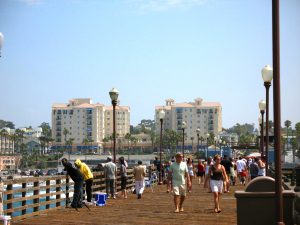
The mackerel gang at the end may be in a frenzy. A “mac attack” is on and the anglers are hooking one, two, three or more fish on every cast. Once hooked, the mackerel and the lines, affixed with bright glow sticks, are headed in every which direction. In response, the anglers are yelling in a polyglot mix of languages trying to keep their lines from being tangled. Or, increasingly, a sea lion is trying to nab the macks before they are pulled from the water; who will win the race? Once up to the pier mackerel are flying in every direction, some may be playing a Mr. Bojangles tune on the deck with their tails; others are in buckets that are overflowing with bloody water. Down the railing an angler may have hooked a big shark or ray and crowds will gather to see if the fight ends in success. Maybe a lobster is pulled from the depth, or an octopus, or a squirming moray eel; all will quickly see an audience of interested onlookers.
Nature itself may be the star. Waves may be slapping the pier’s pilings and the pier may seem to shake. The winds may seem to be playing a harpsichordial tune on the wires and flags at the pier. If it’s a rough sea the ocean may actually seem aglow, phosphorescence created by billions of tiny bioluminescent dinoflagellates in the water.
Then there’s the people themselves, a sometimes-intriguing mix of locals and visitors. One such night I witnessed a group of teenagers huddled around three young men getting ready to dive from the end of the pier near Ruby’s. The three got up on the railing where the leader announced he would do a reverse tuck (I believe). The other two were satisfied to do a simple dive. With cell phone cameras ready to record the action they called out three, two, one, and jumped. The dives were successful and a cheer went up from their friends (as well as more than just a few interested spectators). Soon the young men had climbed the nearby ladder back up to the pier. Last I saw of them was one peering boldly into the back door of Ruby’s. It looked like he was seeking out one of the red-and-white, pinstriped waitresses.
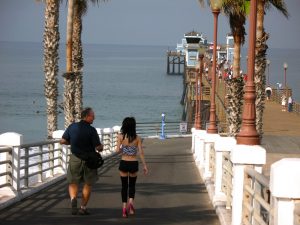
Nearby stood two ravishing young ladies shooting pictures of each other near the pier railings. Around the corner came a buxom platinum blond decked out in Hollywood chic and holding an all white miniature poodle. Next to me stood Jimmy and Eddie, two construction workers from Fort Smith, Arkansas who were taking in the whole scene. They commented that they just didn’t have this action back home. Such is California in the new century—and it can be an intoxicating mix at times.
The Environment. The pier sits over the Oceanside City Beach (a.k.a. Oceanside Pier Beach) a stretch of sand that once was one of the best beaches in southern California. That situation changed in the early ‘60s when a beach and dune area north of the main beach was turned into the Oceanside Harbor. The jetty for the harbor changed current directions and caused a loss of sand to the beaches to the south; eventually the rocky base of the beach was almost bare of sand and it remained a problem for many years.
Today the situation seems to have been somewhat corrected. The beach adjacent to the south of the harbor entrance, Harbor Beach, is given a regular replenishment of sand dredged from the harbor and in turn part of that sand drifts south. Today Oceanside City Beach is wide and sandy. Some even say that a few of the once abundant Pismo clams have returned; things are good.
As for the fishing, Oceanside ranks number one in my records for San Diego County piers. Fifty years of trips have seen a 7.80 fish per hour mark and a 13.5-point per hour mark (my personal method for combining both number and size of the fish). In reviewing the records, the high fish per hour mark reflects some really good days catching schooling species—Pacific mackerel, salema, and queenfish, while the points per hour mark reflects some excellent fishing for croakers, especially yellowfin croaker.
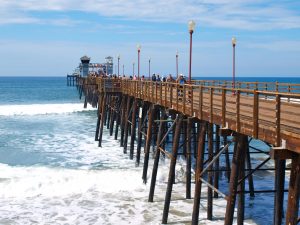
Even better, the pier seems to be about as productive today as when I first fished it in the ‘60s, although quantity is more common than quality. A lot of fish can still be caught but relatively few of the “trophy” fish (i.e., legal-size halibut) that were somewhat common in years past.
The Fish. The fish typically caught here are the normal sandy-shore, long-pier variety but water temperature can have a measurable affect on each year’s catch. As example, the Fish and Game angler surveys done in 2004 showed bonito as the second main catch at the pier (sandwiched between the number one sardines and number three mackerel. However, bonito did not show up in the 2005-2009 surveys; mackerel did not show up in the 2006; sardines did not show up in 2006 or 2008. Granted the surveys were limited but they give an idea of how things can change year to year. Bonito normally show up in warm water years while sardines have had drastic up and down cycles.
However, most years will see the following inshore species—barred surfperch, corbina, yellowfin croaker, spotfin croaker, round stingray, guitarfish, too many (at times) thornback rays, and an occasional California butterfly ray (first recorded from the pier by scientists in 1952), or bat ray. The corbina and barred surfperch will be just outside or even in the surf area, the rest are found from just past the surf area to just past the bait shop
Mid-pier, from the bait shop almost to the end, you will normally find halibut, yellowfin croaker, sargo, white croaker, queenfish, jacksmelt, topsmelt, butterfish, walleye surfperch, bass (both kelp and barred sand bass), Pacific mackerel, more guitarfish, thornbacks, and bat rays along with some sand sharks (gray smoothhound sharks).
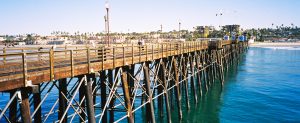
Given the length of the pier, the water out toward the end is fairly deep. That fact means that even though you may still encounter the fish found in the mid-pier area, the end area will offer up more of the pelagic species—Pacific mackerel, jack mackerel, sardines, bonito (some years), barracuda (today, usually a small pencil instead of a log), white seabass (usually small ones called seatrout), and, late summer to fall, an occasional yellowtail (typically a small, firecracker-size fish).
The end area is also were you typically will see salema (at night) and rock-frequenting species like small rockfish and sheephead (only during the day).
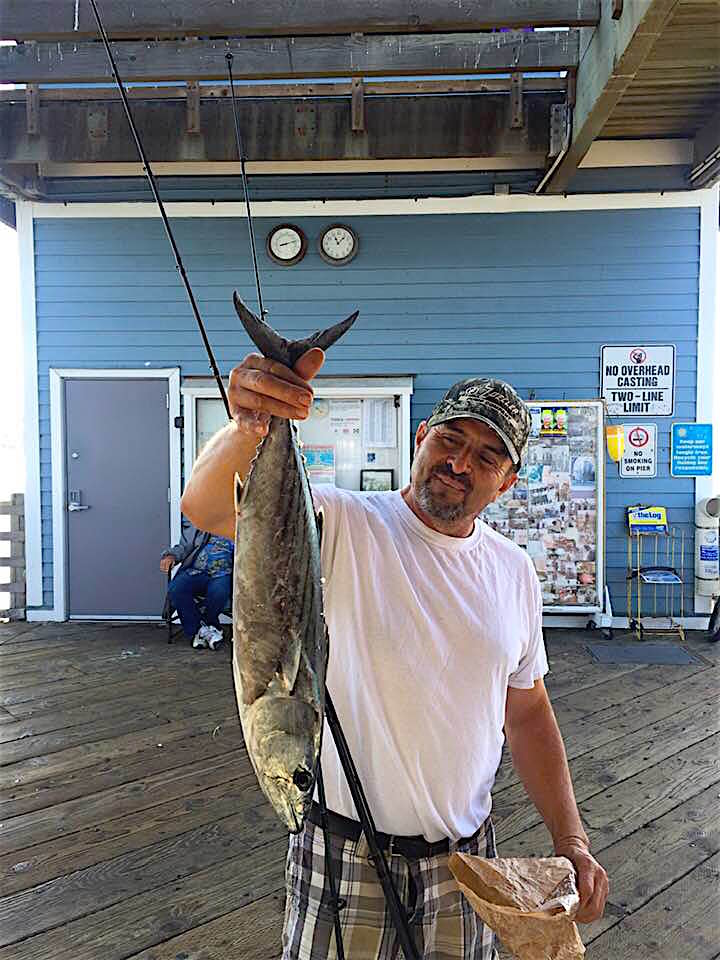
Bonito — 2018 (Picture courtesy of the Oceanside Pier Bait Shop)
Perhaps to be expected, this deeper-water area is often home to the largest sharays, both sharks and rays. Large leopard sharks and threshers lead the list but some big shovelnose sharks (guitarfish) will show up and sometimes huge bat rays.
If the fish aren’t biting just sit back and relax—or head down to the Ruby’s at the end of the pier and have a hamburger, fries and a milkshake. Watch the dolphins that seem to show up most days at the pier and, if it is wintertime, you might even see a grey whale migrating by the pier. The pier is a great spot to simply sit and enjoy the ocean.
Fishing Tips. As mentioned, the pier sees several different zones that contain somewhat different species. There are also zones as far as water depth with some fish being benthic in nature (bottom species), some preferring the mid-depth portions of the water, and some preferring the uppermost layers of water. There are also some species that feed on and usually hang close to the pilings. Adding to the mix are the seasons since some species move into and out of the pier waters dependent upon the time of the year.
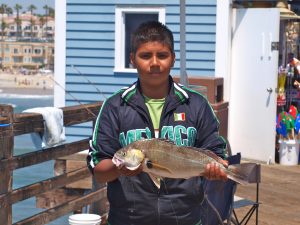
Good-sized spotfin croaker
A wise angler tries to answer the what, when, where and how questions. What species are being sought? When will those species be found at the pier? Where will the species be found? How is the best way to catch the fish if they are present? Success is never guaranteed but answering these questions will lead to greater success.
Inshore is the area preferred by many of the regulars, those who are on the pier almost daily and who are seeking out the larger spotfin and yellowfin croakers, corbina and barred surfperch. All of these species are benthic species that feed on organisms found on the bottom and all are caught fishing on the bottom.
Sand crabs are hard to beat for the corbina and perch but ghost shrimp, bloodworms, lugworms and fresh mussels are primo baits for all of these species—and more. I prefer a high/low set up with a torpedo sinker but many prefer a Carolina rigging; just remember to use fairly small hooks nothing bigger than a size 4 and if using ghost shrimp as bait use a Kahle or similar-type hook.
Best time for the barred surfperch is winter to spring while summer to fall is considered the prime time for yellowfin croaker, spotfin croaker and corbina. However, the bite can start early, especially if the water warms up. May of 2007 saw a run of large spotfins (some exceeding six pounds) with baby mussels being the irresistible bait.
Wintertime can also see big schools of walleye surfperch enter into the inshore and mid-pier areas. They are typically smaller than the barred surfperch but still fun to catch, they are also fairly easy to catch as long as you use small hooks. I prefer a couple of size 8 hooks on a high/low rigging but many people simply like to catch them using a Sabiki-type bait rig, one with smaller hooks. The walleye like to hang just off the bottom to mid-depth so the thing to do is to find the school. Drop your bait to the bottom and if you don’t feel any bites move up a foot or so, continue upward until you locate the school and then keep fishing in that area.
The shallow waters do yield a mix of rays, typically smaller round stingrays, thornback rays, and an occasional butterfly ray. All are caught on the bottom using cut bait—anchovies, mackerel, sardines, and squid but they may also decide to hit one of the baits placidly sitting on the bottom waiting for a croaker. High/low or Carolina riggings usually with a size 4 or larger hook.
Late winter/early spring months may see an influx of small leopard sharks into the shallows. Sometimes there are hundreds of the small sharks, few larger than 24 inches in length—and thus illegal. But, it can be hard to keep them off a baited hook. Just be sure to return them unharmed to the water.
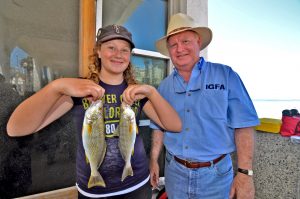
Yellowfin croaker taken at the 2011 UPSAC/IGFA Oceanside Pier Kids Fishing Derby
Mid-pier to the end can yield any of the inshore species but additional species should enter the catch. Benthic (bottom) species include a few yellowfin and spotfin croaker, sargo, China (black) croaker (generally at night) and some of the smaller croakers—queenfish (herring) and white croaker (tomcod). For the larger croakers and sargo use the same baits and techniques as mentioned in the inshore section.
White croaker will hit on a small strip of anchovy or mackerel as well as worms. Most people simply cast out and wait. Better still is to make a cast and then tighten your line as soon as it is cast. The white croaker will often follow the bait down to the bottom and start pecking at the bait as soon as it hits bottom. A slow and steady retrieve will often will allow you to feel the bite and often times will result in a fish on nearly every cast (if they’re in the area). Best rigging: a high/low rigging with size 6 hooks.
Queenfish are found mid-depth in large schools and will often strike on small strips of anchovy or mackerel jigged up and down in a slow manner using a high/low rigging with size 8 hooks. They can also be caught using a Lucky Lura or Sabiki-type bait rig with small hooks. Again drop the line a foot or so off the bottom and move it up until you feel fish hitting your bait (or being snagged on the bait rig). Unlike some species, a slow upward and down jigging motion seems best for the queenfish.
Mid-pier, but in mid-depth to surface water, will see jacksmelt and topsmelt. Wintertime is the prime time for the larger jacksmelt and many of the croaker regulars will switch to jacksmelt for these cooler months. The smelt (actually silversides) can be caught on bait rigs or (as I prefer) a high/low leader with size 6 hooks and a torpedo sinker. I’ll cast the rigging out and start a slow retrieve as soon as it hits bottom. If that doesn’t get a bite, I will sometimes use a float of some type to keep the bait suspended 3-6 feet under the surface of the water. Jacksmelt are not big (few will exceed 15-16 inches in length) but put up a spirited fight for their size. The smelt usually prefer worms or a small piece of shrimp for bait although almost any small piece of bait can sometimes catch them.
This mid-pier area can also be good for the sharays—sharks and rays. Gray smoothhound sharks, their cousins the leopard sharks, thornback rays, shovelnose sharks (guitarfish) and bat rays are the most common. Almost all of these can be caught on high/low leaders or Carolina rigs with the bait deciding the type of fish that will hit. The sharks get all excited and goose bumpy when they smell a bloody piece of mackerel or an oily sardine while the rays love a delicious piece of calamari (oops, squid). All will also hit on live bait, especially the shovelnose, with a live anchovy, smelt, or small perch making great bait. Small queenfish and white croaker (collectively called brown bait) also are excellent bait for the larger sharays.
Two fish common to this mid-pier area are bass, kelp (calico) bass and sand bass. Both readily hit ghost ship and blood worms (probably the best baits) but also will take cut bait, mussels, shrimp, squid and live bait. But, there can be a problem! Both species need to be 14 inches in length to be legal but most that are caught are 8-11 inches in length. Too many people either don’t know how to identify a bass, don’t know the rules, or don’t care about the rules, and too many illegal fish are kept. Some people have been caught and given hefty fines but far too few.
Pelagic species also begin to show up in the mid-pier area. Pacific mackerel are most common but bonito may join them at times along with jack mackerel (Spanish mackerel) and sardines. Some will be caught in this area but the bigger numbers will be at the end.
The prize fish in this mid-pier area is, as at most SoCal piers, California halibut. They are most common from May through July but some will be caught year around. Sometimes the flatties caught in the winter are the largest of the year but you just never know. A fish estimated at 40 pounds was taken in September ’04.
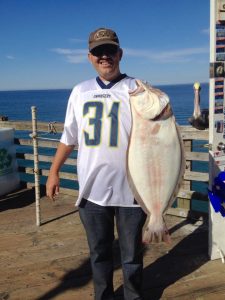
Halibut taken in 2016 (Picture courtesy of the Oceanside Pier Bait Shop)
As for rigging, use a Carolina-rig or another type of live bait rig, i.e., a short (24 inches or so) leader tied a couple of feet up above the sinker. Use a size 4 or 2 hook and a sinker just heavy enough to hold bottom. Lastly, hold your rod and reel, be ready for a strike and learn to feel both the bite and how to respond to the bite. Simply sitting your rod on the railing and waiting for a strike often leads to a missed strike.
Artificial lures can also be used for the halibut but realistically only when the pier isn’t too crowded. The favorite lures for years have generally been swim baits. i.e., a Big Hammer lure or something similar. However, the Lucky Craft Flash Minnow is increasingly being used (usually in grunion or smelt pattern). The halibut are found down in the depressions between the pilings. In response, anglers will walk the pier “trolling” their lures over those depressions. But as said, it’s hard to do if the pier is crowded.
One fish that has been showing up since the 1990s is lizardfish and at times they seem to cover the bottom from the inshore area almost to the end. Some years they are mostly small fish, 6-8 inches long while some years you may see some approaching a foot or more in length. They will hit almost any bait but usually are hooked on smaller hooks and it almost doesn’t matter what type of rigging is being used. Most people hate to see them and consider them a true trash fish but a few ethnic groups do eat them and some people say they make good halibut bait as long as you prevent them from burrowing into the sand. They seem to have up and down cycles with cold-water years seeing the most.
Although anglers seeking out croakers and perch often pack the inshore area, the end area is almost always crowded with anglers seeking out a wide variety of fish. When the mackerel are running, which can be often, the end area will see anglers shoulder to shoulder far into the night seeking out the speedsters.
Generally the mackerel (Pacific mackerel) will hit best on a small strip of squid or a bloody piece of mackerel and as a general rule the mackerel prefer to show up two times a day—early morning and early evening into the night. Many times I’ve seen anglers in the morning go fishless while nearby anglers who arrived an hour or so earlier had a full bucket of fish. Or, I see people leave the pier fishless while as soon as the sun drops the macks are in full attack mode. Nighttime fishing for the mackerel can be exciting. At night you’ll see various rigs, either people using bait or Sabiki-type bait rigs fished under a glow-stick (although 3-5 mackerel twisting up a Lucky Lura/Sabiki leader isn’t so lucky—it often results in the loss of the $2-3 leader). Often when the macs are hitting, glow sticks will be headed every which way and you will need to keep track of which line is yours so that it isn’t tangled with a neighbor’s line. It can be a little crazy at times but fun.
Bonito are considered a prize when they show up. The bonito, mostly in the 1-3 pound class but occasionally including some large 6-8 pound fish, generally hit during the day (especially at dawn) and prefer a splasher-type rig (a wooden ball, a cast-a-bubble, or a golf ball—with a green and white colored feather trailing behind it). However, spoons—Megabaits, Kastmasters, or Krocodiles have become increasingly popular for the boneheads.
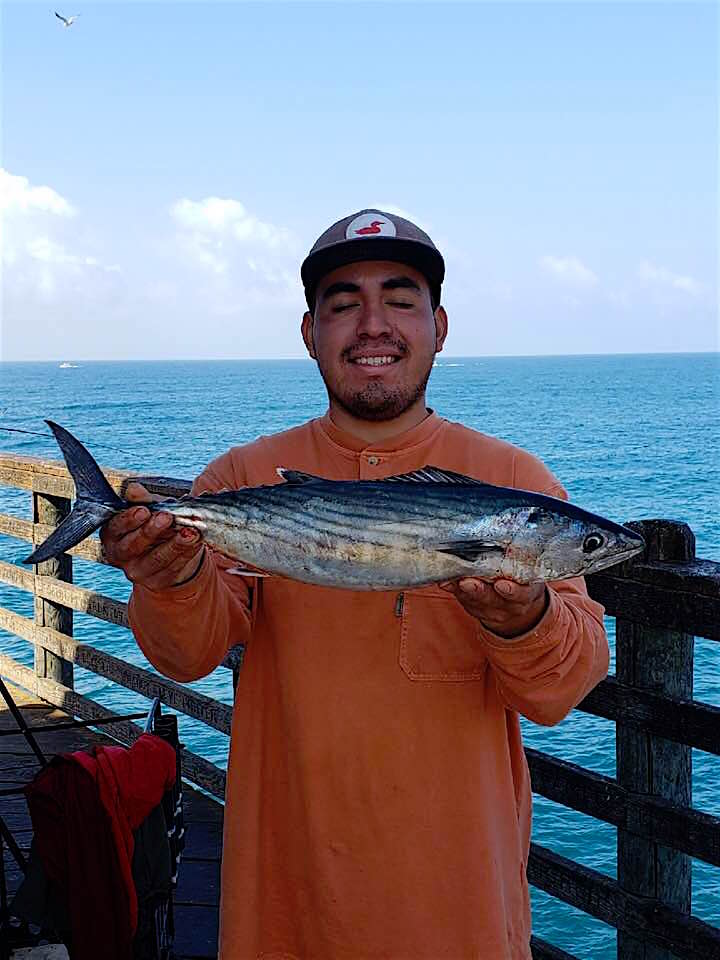
Bonito taken from the pier in 2018 (Picture courtesy of the Oceanside Pier Bait Shop)
Late summer to fall months will also see some barracuda, mid-pier to the end. Most of the barries show up at night and your best bet to catch them is generally a gold- or silver-colored spoon like a Kastmaster or Krocodile. Do be sure to check size regulations for the barriers since most will be undersized and should be returned, unharmed, back to the sea.
As mentioned, most years will see some yellowtail show up, usually in the August-October months, and most will be the smaller firecracker-size fish. That can change during El Niño, warm-water years. More fish will show up, the run can start earlier in the summer, and larger fish may also visit the pier. As example, during the El Niñoconditions in 2015 there was an extended run of yellows in September, mostly firecrackers but also some of the larger “tanker” size fish.
The rock quarry artificial reef out toward the end of the pier will attract salema and other rock-loving species. Unfortunately, people literally catch and keep enough of the small fish to fill buckets even though the limit is ten. Hopefully some of the people will face some stiff fines one of these days. A high low set up with size 6-8 hooks and a small piece of bait—worm, strip of squid, small piece of shrimp or even cut mackerel fished mid-depth will yield the salema.
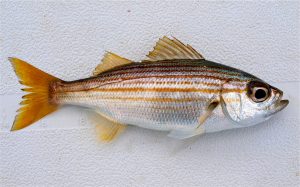
Salema
Winter months, usually at night, will see sculpin (California scorpionfish) showing up. They prefer a strip of squid or shrimp on a high/low rigging and are caught on the bottom. They are delicious to eat but be very careful in the handling since painful stings can occur from the long spines. If stung, hot water applied to the wound may provide some relief.
Another rock-loving species is sheephead and though fairly uncommon, quite a few of the fish have been caught out at the end of the pier. Included were some good-size sheepies (12 and 27 pounders in April 1998, a 32” fish guesstimated at 20 pounds in November 2002, and a 20+ pound fish in January of 2003). In most instances the bait was ghost shrimp or pieces of market shrimp although crabs and mussels are also good bait, and both bloodworms and live anchovies have been reported as successful baits at the pier. If you want to try to catch one of the big-toothed creatures be warned that they only feed during the daylight hours (they sleep at night) and are most common during the winter months.
Although not considered a great pier for sharks, enough are taken to keep the local sharay (shark and ray) fraternity busy. Most are caught at the end and regulars say a long cast out from the southeast corner of the pier gives the best chance for one of the bigger sharks. The usual suspects are encountered—leopard sharks, gray smoothhounds, spiny dogfish, shovelnose sharks (actually a guitarfish), bat rays and thresher sharks. Every so often a large 7-gill shark or soupfin shark will show up to keep things interesting.
Blue sharks occasionally wander in from deeper waters; mako sharks do the same at times. A mako estimated at 8 feet in length was lost at gaff in 2015; a 7-8 foot mako was landed in April of 2016. In warm water El Nino years it’s not unusual to see hammerhead sharks like the small one seen next to the pier in August 2015.
Increasingly, great whites are also showing up and though most are small juveniles, a pretty large one showed up in September of 2016 (and remember that it is illegal to take a great white). Another large shark, first reported as a great white, showed up in July 2015. As it turned out the approximately 12-foot long shark was simply a harmless basking shark (that strains plankton through its gills for food).
Best bait for most of the legal sharks is a large, bloody piece of mackerel while the threshers prefer a live mackerel on a sliding leader.
One of the larger sharays is shovelnose guitarfish usually simply called shovelnose sharks. Most that are caught are around the three foot size but occasionally fish approaching five feet in length will be caught.
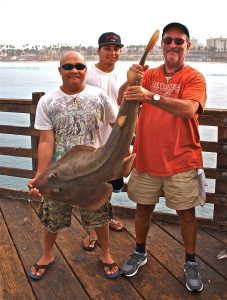
Shovelnose shark (guitarfish) taken in 2015
Generally the largest of the sharays will be big bat rays that are affectionately called “mud marlin” by the pier rat community. Most years can see bat rays being landed that exceed 80 pounds in weight; some years will see fish over the 100-pound mark (and they are always the old mama fish). One that weighed an estimated 150 pounds was taken in April of 2001 and another, guesstimated to weigh over 200 pounds, was caught in April of 2006. March of 2010 may have seen the greatest number of big fish when over a dozen bat rays exceeding a hundred pounds were taken (along with a plethora of small rays). The bat rays prefer squid for their meals although anglers sometimes try a potpourri of baits (including stuffing a squid with anchovies or other fish). Do remember that if you’re seeking out the big critters to bring a net and someone to help you with the net. It’s reported to be 32 feet up from the low water mark to the pier surface.
A somewhat special environment is found around the pilings, generally the pilings found mid-pier to the end. Certain fish stay close to and feed on the mussels, crabs, shrimp, and other food that lives on the pilings. Circling around the pilings, and usually near the top of the water are large pileperch. Down near the bottom or often a couple of feet from the bottom will be blackperch (aka buttermouth perch) and rubberlip seaperch. If you’re lucky you might even encounter a cabezon, which almost always hangs near the bottom of the pilings, often under mussels on the piling. Near the pilings, but generally found mid-pier more than toward the end are some opaleye and halfmoon. Both of the latter are good fighters and the opaleye in particular can reach pretty decent size.
When fishing around the pilings, try mussels, bloodworms, or ghost shrimp; use a bait holder-type hook for the bloodworms and mussels, a Kahle-type hook for the ghost shrimp. Oldsters would sometimes take a small clump of mussels, wrap a line with several small hooks in the mussels, and drop the whole clump down toward the mussel-encrusted pilings. The result can be some big perch. In addition, small sidewinder crabs make excellent bait for all of these fish; hook them under the rear part of their shell with a size 6 or 4 hook. A check of the inshore pilings under the pier can sometimes yield up some of these small crabs for bait.
Given the size of the pier, and the number of anglers, it’s not too surprising that some unusual fish may also show up at the pier.
A favorite Central California species but uncommon to Southern California piers is striped bass. Nevertheless, a 27” striped bass was taken in July ‘00 and another 37” striper taken in November 2015. A fish also common to the north but rarely seen at SoCal piers is grass rockfish but one was caught in April of 2015.
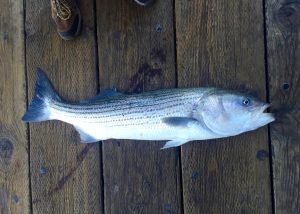
Striped bass taken in 2015 (Picture courtesy of the Oceanside Pier Bait Shop)
Although not really rare, basketweave cusk-eels (Ophidion scrippsae) are an infrequent catch from piers yet scientific records list at least two of the cusk-eels as being taken from the pier—in 1947 and 1966—and I’m pretty sure there have been more.
Bonefish (Cortez bonefish, Albula gilbert) have made occasional appearances. A 13-inch bonefish were taken in February of ‘01 and another was caught in August 2007. An earlier report from 1963 showed an even greater catch of the elusive bonefish:
John E. Fitch, research director of the DFG Marine Resources Operations on Terminal Island (reports) fishermen have been catching from one to a half-dozen bonefish daily off the Oceanside Pier. Either there has been a successful hatch in our waters in recent years or these fish have wandered north with a tongue of warm water in late September and October. —Donnell Culpepper, Fishin’ Around, Long Beach Press-Telegram, November 13, 1963
A fairly rare species taken at the pier was a deep-water lancetfish. Even more rare was a Pacific tripletail (Lobotes pacificus) caught in early October 2014. Typically found in the Sea of Cortez, and along the Pacific coast of Baja California south of Guerrero Negro, only a few of the fish have ever been taken in California waters. As evidence of the warm waters in 2014, another tripletail was taken in San Diego Bay in August of the same year.
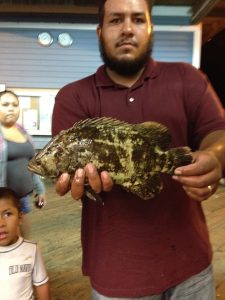
Tripletail
An unusual fish due to its size was a 9-pound kelp (calico) bass caught by a neophyte angler in September of ‘02. He rented a pole, bought some frozen squid, and headed out from the pier’s bait shop. A short time later he came back to the shop with the huge calico. Most anglers will fish a lifetime from a pier and never catch a 9-pounder (in fact, it’s a pretty good calico even from a boat).
A fish that was becoming rare, and was considered endangered just a couple of decades ago, is the giant (black) sea bass, a goliath of the sea that never fails to startle pier fishermen used to the smaller species. The earliest PFIC reports of a giant sea bass capture at Oceanside was a 143-pound fish that was hooked on Memorial Day Weekend in 1997. Three drops of a treble hook gaff were needed to snag the fish and then four people were needed to haul it up onto the pier. These bass are of course illegal and the smart move would have been to simply cut the line when the angler saw what it was. Instead, the determined angler headed up the pier dragging his catch behind him—only to meet a game warden coming down the pier. It was a TRULY DUMB act and the fine is around $2,000.
Then, in the fall of 2002, several were taken during September and October—including one that most of the regulars said would have topped 200 pounds if not released. May of 2003 saw a fish estimated at 150 pounds, a “giant” fish was caught on July 4, 2008, and a fish estimated at 200 pounds was seen in early June 2009. That fish was hooked on heavy line and wound up tangling the line around the pier’s pilings. Eventually the bait shop was able to contact lifeguards who swam out to the fish and cut the line allowing it to swim free (nice job!).
Huge black sea bass hooked in Oceanside
Raul Espinoza may think about Ernest Hemingway’s quote when he’s fishing for huge thresher shark on Oceanside Pier, but he never dreamed he’d catch something much larger. “My big fish must be somewhere,” Hemingway wrote in “The Old Man and the Sea.”
Espinoza hoped his big fish would be a huge mako shark that he has caught and lost three times, but earlier this week he hooked into a monster black sea bass that took him more than three hours to bring in. Because the fish is protected, he also carefully handled it to make sure it revived and returned to the deep.
Espinoza, 36, has been fishing on Oceanside Pier since he was 5 years old. He loves to fish for shark, often during the wee hours, and headed out last Saturday with that in mind…
On this night, he was out to catch mako shark. He used a whole mackerel on 40-pound line and a 50-pound leader. Just before 3 a.m., he started getting a nibble. “I know exactly what time it was because I had just looked at my watch at 2:50 a.m.,” Espinoza said. He expected a shark to be nibbling lightly. “I set the hook and it peeled out and started pulling line. I couldn’t stop it,” he said. He was sure this was the large mako weighing about 450 pounds that he hooked three times before. Each time he lost it. “I was taking my time, because this time I wanted to tire him out and not lose him,” Espinoza said. After stripping about 400 yards of line, he slowed down and Espinoza was able to lock down his drag and start cranking. “I was able to recover a couple hundred yards of line until he started running again. He did this seven times until I got him to the pier at 6 a.m.,” he said.
It was only then he realized he had hooked the protected fish. State law requires they be safely released… Once he realized this was a protected sea bass instead of a shark, it was a different ballgame. “Things changed once I knew I had the bass. It was now survival mode,” Espinoza said. “I had to make sure it survived.”The small crowd of night pier anglers had gathered to watch and was stunned by the size of the fish. They rooted Espinoza on.
The huge fish began pulling under the pier and Espinoza worried he would tangle or break off on the pilings. The fish was exhausted and Espinoza wanted to keep control so he could make sure the fish recovered safely. To do this, he climbed down a ladder to water level, but large swells made it dangerous. “I waited to see if it was OK. Eventually I could see it was revived and ready to go, so I cut the line,” he said. The big fish turned and took off.
At that point, all Espinoza could do was sit down. “I was exhausted, my muscles ached, my shoulder out of place, and it’s taken me five days to recover,” he said. He got lots of high fives and congratulations after the successful release. “No one realized there was a fish that big in the water around here,” he said… After a few minutes, Espinoza baited his hook and was back in the water. He went to work that day and returned that evening. It was hardly an eventful fishing trip, however, only landing an 80- to 90-pound bat ray.
—Ernie Cowan, San Diego Union-Tribune, June 30, 2016
Today there are almost regular reports of anglers hooking the large bass at the pier and occasional stories of knuckleheads who think they should keep them. In response, Fish and Game “sting operations” are run fairly often at the pier so don’t join that group of knuckleheads.
Cephalopods. Another giant, although of a quite different species, is the Humboldt squid and every few years will see a run of the large cephalopods at the pier. One such run, although short lived, took place in May 2007 and resulted in the usual crowds and excited anglers hooking the large (up to around 30 pound) squid.
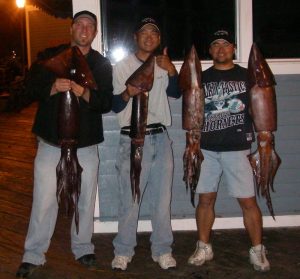
Humboldt Squid — 2007
A cousin cephalopod, although of a much more diminutive size, are the small octopus that are sometimes encountered while fishing at night from the end section, especially in the winter months.
Crustaceans. Although not really noted as a great pier for spiny lobsters, many bugs are taken every year. If it’s not the normal fall-winter month’s season do not keep them. If it is during the legal season, remember that they can only be taken with hoop nets (not on a rod), must be legal size, and you need a lobster card to keep them. Most of the bugs will be taken at night and some are pretty good-sized.
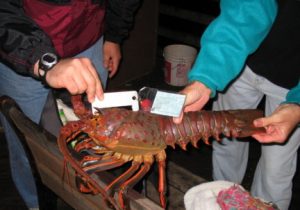
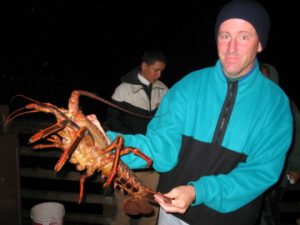
Lobster taken in 2015
A few crabs, crustacean cousins of the lobsters, may also be landed. Most of these will be the big, gnarly-looking spider (sheep) crabs and though ugly, and not the easiest thing to clean, they are good eating. Occasionally a rock crab, usually a yellow rock crab, may also show up but rarely are they in the numbers or of a size to justify a hoop net expedition for crabs; they’re strictly an incidental catch.
Non-fish. Other creatures are occasionally encountered.One catch that I found interesting was a tropical turtle that was caught by a startled angler on July 4, 2000. The creature was netted, the hook removed, and the big fellow (or girl?) was gently lowered back down to the
There’s truly a plethora of species to be caught at the pier and though most will be the common species, you just never know what you might catch.
Da Birds. Visit almost any pier and you will probably see some birds—pigeons, sea gulls, cormorants and pelicans being most common, while herons and egrets are regulars at several piers.
The pigeons are actually usually tame and not bothersome although they, like all birds, can leave a mess on the pier. Sea gulls are sneaky and a pest. They will patiently sit on the railing until you forget they are there — and then grab any unattended bait or fish. Cormorants do their dirty deeds under water where they swim and grab fish, including hooked fish at times. Pelicans are big and they can be aggressive. They too will grab unattended bait and fish but they also will sometimes try to grab fish (even fairly large fish) still attached to a line, a fact that doesn’t make anglers too happy. The herons and egrets tend to be more cautious and are rarely a nuisance although they also will grab unattended bait and fish left by careless anglers.
Of the mix, the pelicans seem to be the favorite of tourists to the pier. They’re big, kind of awkward, and goofy-looking birds that seem well suited for a Jurassic Park/World movie (fitting since they appeared during the dinosaur era and they resemble the extinct pterosaurs). They have also become the favorite additions for people taking “selfies” on the pier. Of course that innocent-looking pelican, sitting placidly on the railing, will also reach out and bite you if you get too close and seem threatening (and it can be a painful nip).
The Oceanside Pier sees all of these birds but as expected the pelicans are the favorites. Although there were a number of different pelicans over the years, one of the favorites was Charlie, a seemingly staid and gentle bird that most days would be sitting on the trashcan near the bait shop (where he got a LOT of attention). People would line up to get a picture with Charlie. Ed Gonsalves, who owns the bait shop has even been known to toss an anchovy or two at the birds which seemed to keep both the birds and tourists happy.
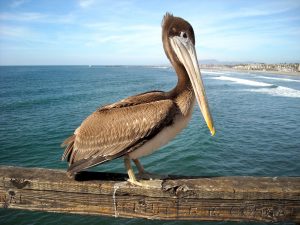
Charlie
Ed will never admit he’s soft hearted for the birds but he is. One pelican showed up in the winter of ’18 with a torn pouch (it can be tough dive bombing from a high altitude (40 feet or so) into the sea in pursuit of fish—as pelicans are known to do). The bird, obviously injured, landed next to the bait shop, and then, when people were busy, strolled right into the shop.
Ed ushered him out but worried about the bird so he called a number of different animal agencies for help and advice. Unfortunately, no one offered much help but at least Ed could try to feed him and he managed to get a few anchovies down his throat.
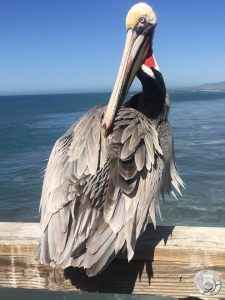
Michael (Picture courtesy of the Oceanside Pier Bait Shop)
Birds learn fast — and know a sucker when they see one. The bird kept showing up, kept walking into the shop, and grabbed bait whenever available. But, there was a shortage of anchovies and they were expensive. Ed put out the word that some small fish to feed the pelican would be appreciated and the regulars responded with more than enough fish to feed the bird until it was healthy. Since the bird liked to bob and weave — and dance around — he finally acquired a name — Michael Jackson, and now he’s a star at the pier.
Ed though may have gone a little too far when he decided to paint Michael’s toenails pink. Michael didn’t seem to mind and tourists loved it. Ed would tell them that it was pelican breeding season and he wanted to give Michael an edge up when Michael was out there seeking a little female companionship. One day one of the regulars brought down some glitter but to date it’s still sitting on the shelf and da bird still has his pink toes.
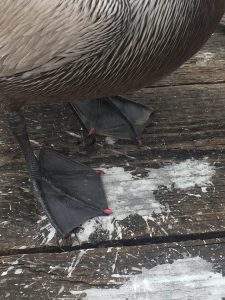
Michael’s pink toes (Picture courtesy of the Oceanside Pier Bait Shop)
Of course the herons and egrets spotted these freebies for Michael and they too felt they deserved a meal — and Ed obliged.
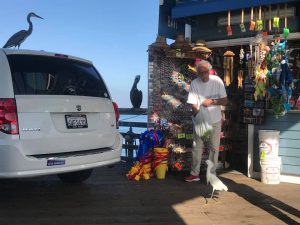
Ed feeding breakfast to Michael the pelican, Herman the heron, and a snowy egret.(Picture courtesy of the Oceanside Pier Bait Shop)
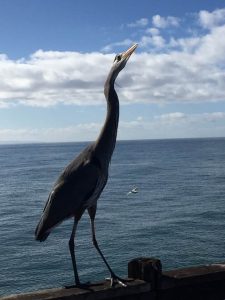
Herman the Heron (Picture courtesy of the Oceanside Pier Bait Shop
It’s hard to say how long Michael will stay at the pier and how long the “Oceanside Pier Wild Bird Act” will continue but the cast and audience — the birds, Ed, and the tourists, all seem to enjoy the show.
Special Recommendations. A lot of small, undersized (and illegal), white seabass (generally called seatrout by anglers) are caught on this pier. Please return them to the water and help this species once again become a viable resource. You may also avoid a large fine and the loss of your fishing license!
Potpourri — some articles and (hopefully) interesting facts about Oceanside’s Favorite Pier
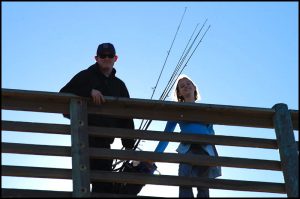
Pier Rats — Garth and Lisa
<*}}}}}}}}}>< — No boats necessary — Dedicated pier patrons are proud and happy to spend their days fishing from California’s shoreline pilings
Basketball has its gym rats, golf has its range rats and, yes, fishing has its very own pier rats. They are a special breed of angler, these fanatics who fish from pilings, whether they be concrete or wooden. Pier rats don’t care. “Our motto is no boats, no kayaks and no freshwater for posts on our board,” said newby pier rat Garth Hansen of Escondido. Their message board is on www.pierfishing.com.
In his excellent book, “Pier Fishing in California,” Ken Jones, the modern-day Pied Piper of this new breed of pier rat, leads his cult-like followers to 113 piers, including those in the Carquinez Strait (about 20 miles northeast of San Francisco) and West Delta. In his second edition of the book, Jones includes an enlarged fishing-tips section and also details a history of the piers. There’s an entire section on fish identification, and he tops it with a section called “The Pier Rats Speak,” a dozen classic posts from the “Pier Fishing in California” message board on www.pierfishing.com.
At a recent get together at Oceanside Pier, Hansen was joined by John Kim of Carlsbad, Reid Mimaki of San Marcos, Rod Mina of San Diego and Rich Reano, the site’s Web master from Chula Vista, for some early-morning shore fishing followed by a trip to the pier.
Hansen discovered the group while searching the Web one day. “The fishing report is one of the more useful things about the site,” Hansen said. “I’m a beginner, so it helped me with good fishing information and tips. I took my daughter out to the pier the first time. Except for a 16-inch smelt, we got skunked. But since then I’ve landed my first legal halibut, first legal sand bass and way too many croakers.”
Reano fished from the beach early and, like the others, landed a handful of barred surf perch. He used a unique offering, a size 8 Wooly Worm fly with a half-ounce barrel sinker, a standard Carolina rig. Reano has been the group’s Web master since 1997. “We get just over a half million page views a month,” Reano said. “We’re small compared to boards like Allcoast Sportfishing, but for pier fishing, we do OK. We have a narrow focus, but still have a lot of views for that.”
There are 8,000 registered members of the board but, as Reano said, “many more lurking out there.” Mina said the reports and pictures that pier and shore anglers post make the site valuable to those looking for information, tips and places to fish. “Part of it is people want to educate others about pier and shore fishing, but part of it is people want to brag, too,” Mina said.
The group stresses that all pier and shore fishermen follow Department of Fish and Game regulations, a big issue on the state’s piers. Many pier fishermen are recent immigrants who often plead ignorance on fish and game laws. They have a reputation with other fishermen for taking over-limits and fish or lobsters out of season. “We place a huge emphasis on rules,” Reano said.
Ben Acker and Bryan Burch traveled from Pasadena to join the others for the rare get together last Saturday. Acker, a sixth grade teacher in Arcadia, is a veteran hoop-netter and pier angler. “I have five younger brothers, and my mom said the only thing we could ever do without fighting is fishing and singing,” Acker said. Acker converted an old baby jogger into a fishing pier buggy that he loads all his gear on for an easy trek to a spot along the pier’s rail. As Acker was setting up his gear, a tourist passed by and said: “Do you need a fishing license to fish on a pier?” Acker responded, “No.” And the guy winced and said, “I just lost a $5 bet with this guy because I bet him you needed one.”
Anglers don’t need a fishing license, but knowledge of the shoreline structure under the pier is a huge benefit. And knowing how to rig for the various fish is equally important. “It’s a sharp learning curve, but if someone puts the time in, it’s not that hard to learn,” Acker said.
Acker said piers are the best-kept secret for hoop-netting lobsters. “I’ve probably hoop-netted more lobsters from a pier than I have from my kayak,” said Acker, who has his own special way of lowering his hoop net. He cradles it under his arm and tosses it the way someone would toss a discus. He got a good 30 yards on his toss on this day.
Down the pier from Acker, Daniel Elrod of Lancaster, another bona fide pier rat, displayed his invention, the L-Rodholder that he uses for rods and even a pulley arm for pulling hoop nets up from the depths. He sells them for $45 to $59. “I’m 46 years old and I’ve been pier fishing my whole life,” Elrod said. “My dad started me out when I was young.” Elrod said he visited Ocean Beach Pier during lobster season last year and asked a hoop-netter there if he’d like to sample his pulley arm device for pulling up his net. Elrod said the man hoisted up 30 lobsters in two hours before the men were kicked off because there was an electrical problem on the pier. “It was the middle of the day, too,” Elrod said. “I mean every pull, every 15 minutes, he’d have five, six lobsters in there. It was incredible because they were all keepers (legal-size) except for one.”
Elrod had his 14-year-old son, Kyle, along with him, doing his part to pass on the pier-rat tradition. “I’m on that pierfishing.com site every day,” Elrod said. “It’s an addiction. I like to read what’s going on in Northern, Central and Southern California, and it’s a great place for that. Everyone has their own style of fishing, their own personality. But by knowing what’s going on along the whole coast helps me plan my own fishing trips and excursions.”
Boyd Grant is vice president of United Pier and Shore Anglers of California. He travels in his motorhome and checks on piers. He’s a mobile pier rat with a shell. “I’m a full-time volunteer and field representative,” Grant said. “I drive the entire coastline and check out the beaches and the piers. I have over 30 years of fishing every pier in California.” Grant said one of the other features of www.pierfishing.com is that it includes a link to Ken Adelman’s www.californiacoastline.org. The site offers up-close and updated looks at beach access and fishing areas. Grant called “Pier Fishing in California” author Ken Jones “the best piling fisherman I’ve ever seen.” “When we go to Catalina, we get 20 fish. He catches and releases 200 or more,” Grant said of Jones. “I don’t care where it is. Any pier, any piling. He’s the piling master.” Grant said he loves the entire atmosphere that can usually be found on a fishing pier. “There’s a lot more to pier fishing than just hooking fish,” Grant said. “I’ve found that no matter where in the world we go, when we visit a pier we have so much in common with the people there. Within five minutes, we’re talking like we’ve known each other all our lives.”
As Grant spoke, the Flatt family fished behind him on the north side of the pier. Steven and Melissa Flatt were there with Kalyn, 2. It was a family, glad to join the ranks of the pier rats. “He wanted a fisherman, so Kalyn now is into fishing,” Melissa Flatt said. “This is her first time fishing the pier, but she’s caught bluegill and has fished in Yosemite already.”
—Ed Zieralski, Outdoors, San Diego Union-Tribune, January 22, 2005
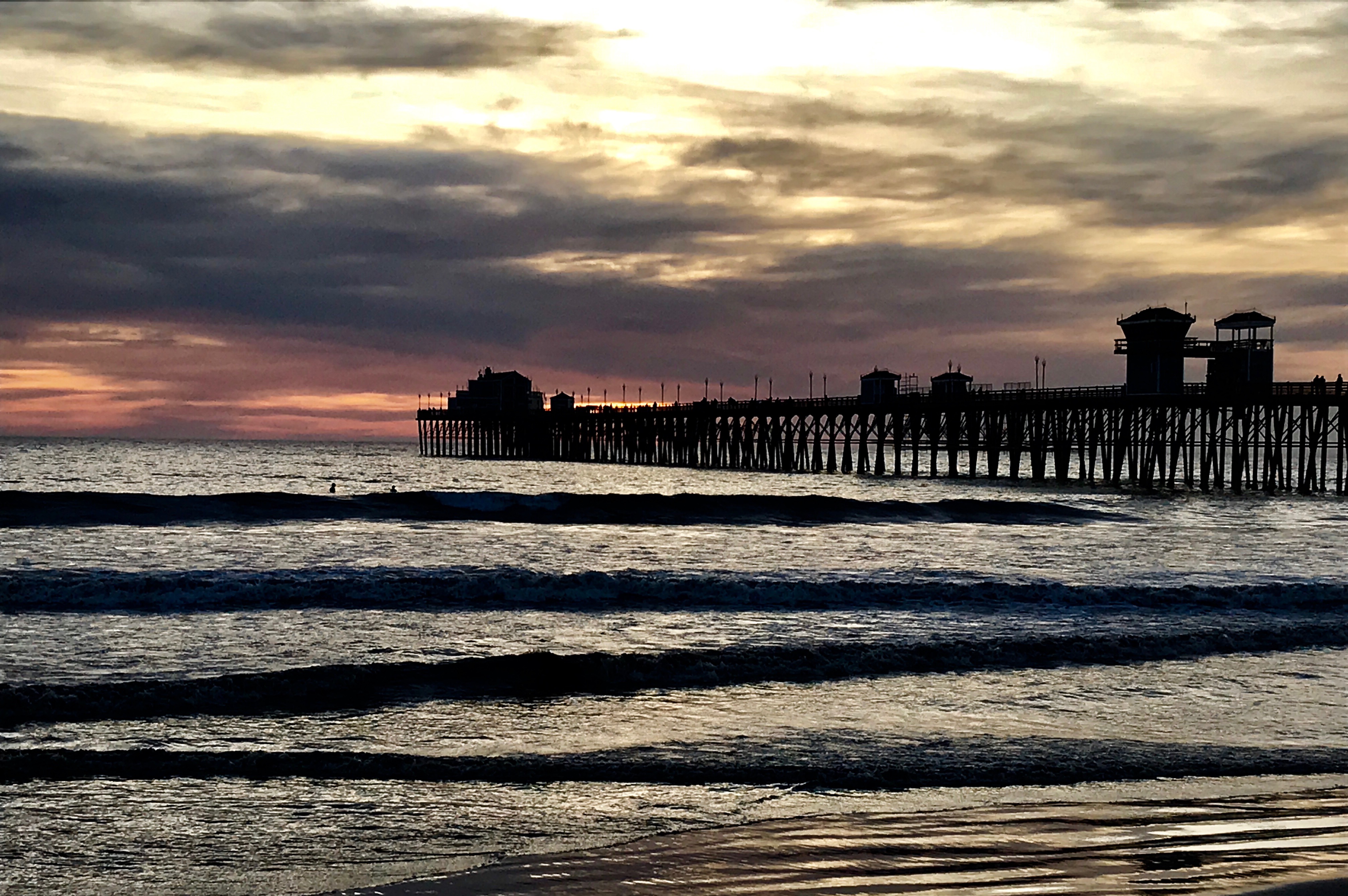
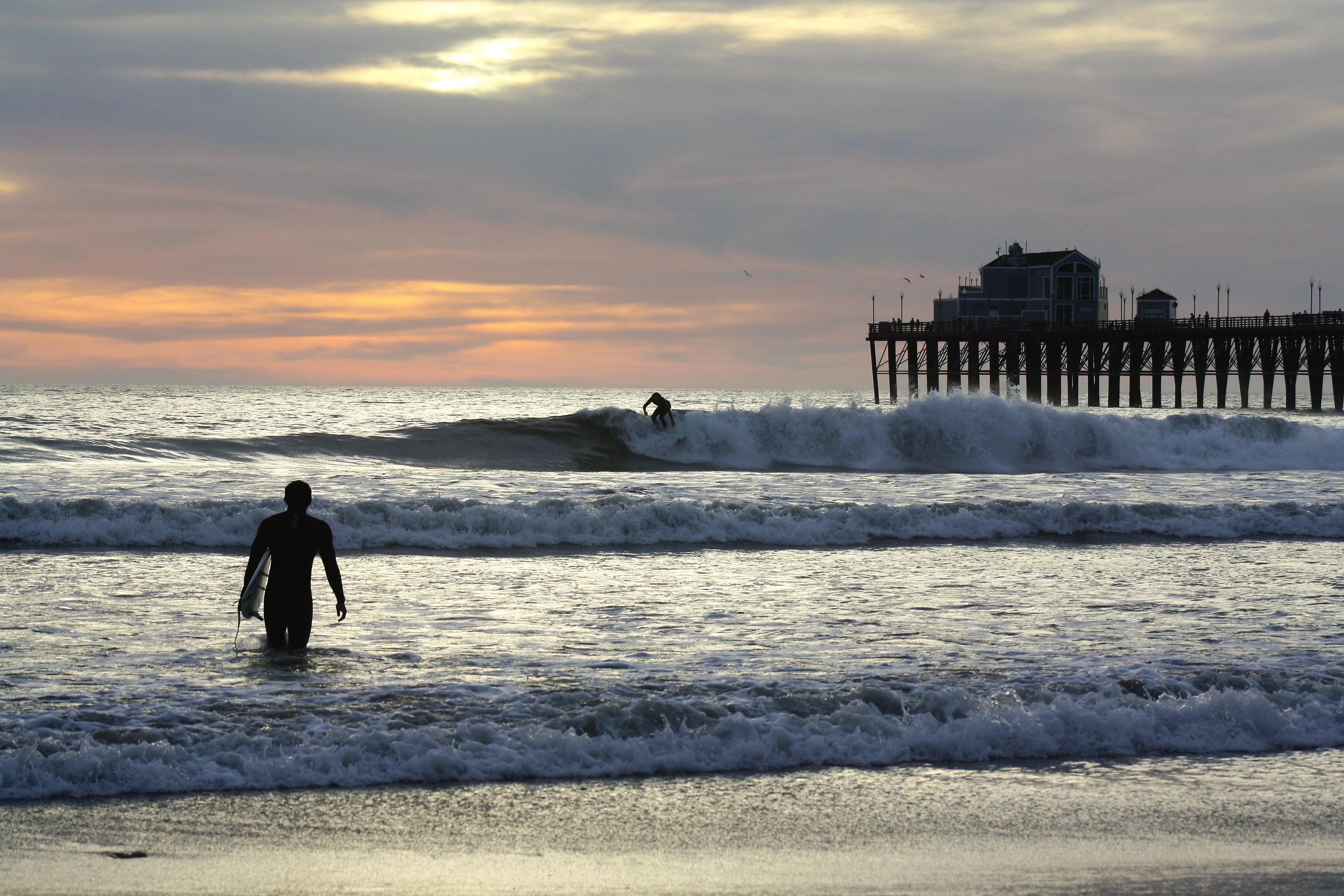
Pictures courtesy of my son Mike
<*}}}}}}}}}>< — Fishing at a pier can teach many lessons about life. Here we’re presented the age-old question: Is a fish story really a lie?
We Get Hooked on Fish Story
Carlsbad, Calif.—There has been some fishing and some lying, none of it too successful. As is customary, we visit the Oceanside pier from time to time while on vacation here to (as I believe they say it) wet a line, but mainly, I think, to get hot chocolate and doughnuts at the end of the pier. ,
The fishing is secondary. It is nice that way. It’s regulars, the old folks who settle down for the day with sack lunches, folding chairs and battered straw hats, put their lines in, but they are there to visit and take the sun and breeze. Mine just happen to take the hot chocolate.
The sports congregate at the end of the pier, probably 1,000 yards out from shore, and they are elbow to elbow and intense and want the fish to bile. One old girl, about an ax handle across the stern, seemed to be the star performer out there the other day.
She was dressed in jaded blue overalls, with a man’s blue work shirt buttoned at the neck, canvas shoes and a wide straw hat with the trailing edges reaching her shoulders. Probably she was in her ‘70’s but she whooped and hollered every time she pulled in a fish and she truly seemed to have the touch.
As I walked by from the end of the pier with a black coffee “to go,” her pole bent sharply again, waving, and she warhooped again.
Well, this is the serious fishing spot, and I suppose that it is because it is farthest from land, but you can’t fool ‘em about halfway out in. I have caught halibut there, and mackerel, tomcod, rays and small sharks, but the best thing to do is visit the small fish market located there.
The children got bored the other day after about 15 minutes and left me with the poles while they trooped out for chocolate
“Give me two bonitas, please,” I asked the young fellow behind the counter. I dropped them in my sack.
And I was standing there, looking rather unconcerned, line in the water, when they came back and asked what was in the sack.
I told them to look. “Gee, did you catch those?” the young fellow yelled. “He bought them at the fish market,” his slightly older and wiser sister stated. “Let’s tell them we caught them when we get home.”… her brother was enthused with the plan. “Yeah.” He said. “You caught one and I caught one. I get to carry the sack”…
Parents are supposed to teach their children that lying is dreadful, leaving them to pick it up as they mature. “This is not really lying.” I told them, and they nodded. “This is what they call a fish story, and it is different.” They nodded again.
They went roaring into the house when we got home, displaying their trophies. The big girl looked up from her book. “You bought those at the pier, didn’t you?” she queried, “Yes,” I said. What a know-it-all.
—Bill Sumner, Vacation Report, Pasadena Independent, August 17, 1961
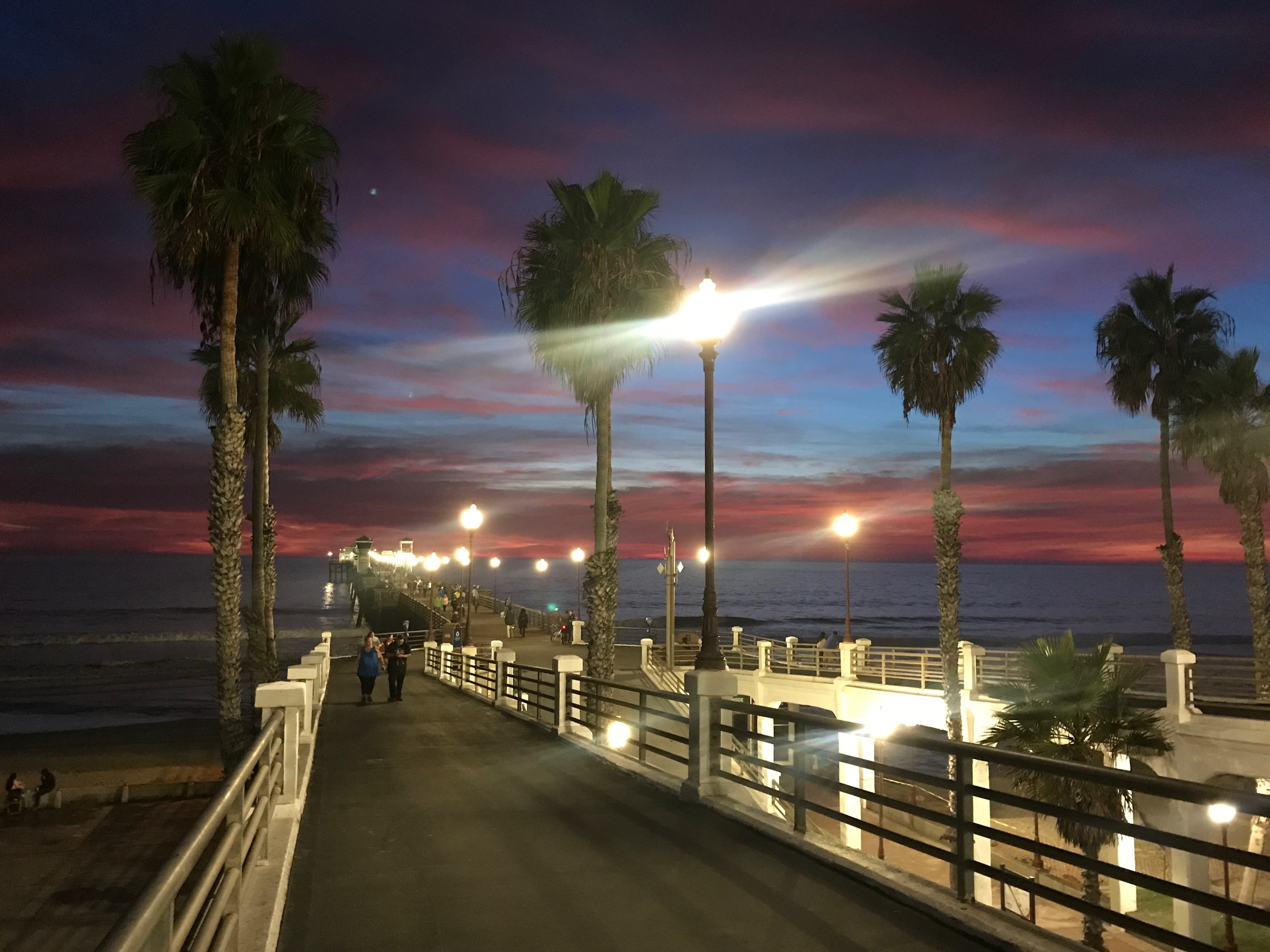
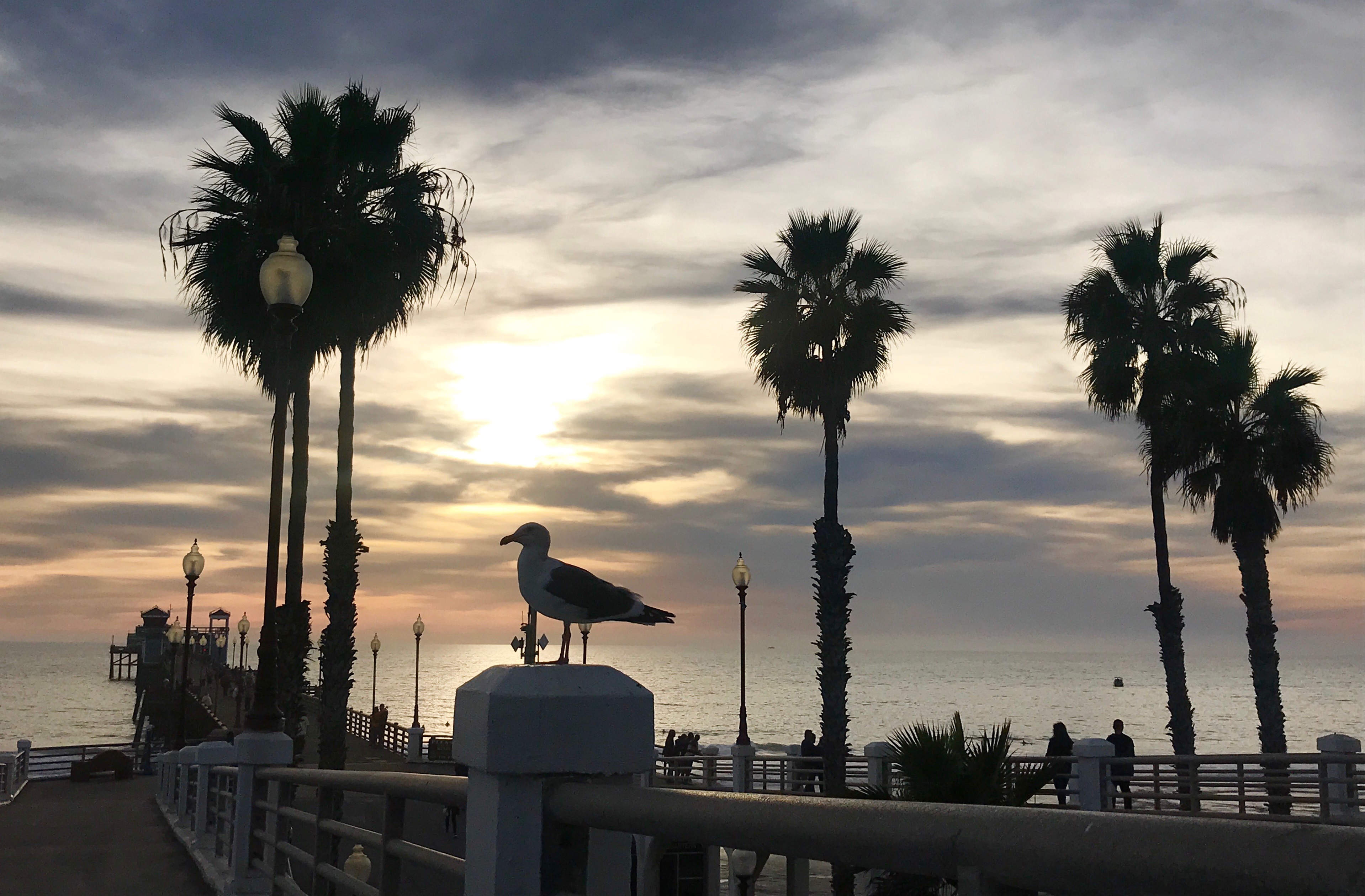
Pictures courtesy of my son Mike
<*}}}}}}}}}>< — Although fishing is the main occupation employed on the pier by anglers most of the year, winter months see people out, primarily at night, in search of the bugs — spiny lobster. Rare is the day when one like the following is encountered.
Persevering twins reap late reward of one giant lobster
It was another marathon Saturday with dad, starting with a 6:30 a.m. tee time and finishing at midnight at the Oceanside Pier. But it turned into a very special day for Blake and Garett Spencer, a pair of 9-year-old twins who teamed with their father, Todd, to catch a lobster of a lifetime.
“Saturday is my day with the boys, and we started with 18 holes at Temeku (Golf Course),” said Escondido’s Todd Spencer, manager of a collection agency. From there, it was on to Oceanside Pier for some hoop-netting for lobsters, an activity the boys later told their dad they’d pick over playing video games.
“This was only our second time hoop-netting,” Spencer said. “We went at the end of last season and fished off Ocean Beach Pier. We didn’t get anything, but the boys loved it.”
Last Friday, the boys asked their father: “When are we going lobster hunting again? Spencer promised they’d go after his golf outing the next day. They packed their rig with items that don’t necessarily go together like ham and eggs: dad’s golf bag and gear, a couple of hoop nets and 2 1/2 pounds of mackerel for lobster bait.
Golf and hoop-netting, an outdoorsman’s daily double, for sure. Golfing done, Spencer said they arrived at the Oceanside Pier at 6 p.m. and started fishing the windward side of the pier. “We were the only ones with hoop nets, and I was beginning to think the Oceanside Pier wasn’t the right place to hoop-net for lobsters,” Spencer said.
He turned to his boys after a few hours of not getting anything and asked them, “Would you guys rather be home with your new X-Box games, or would you rather be out here on the pier fishing and not catching anything?” They chose being on the pier over playing video games. This was more fun, and besides, it was quality time outside with dad. “That made me feel pretty good,” Spencer said. “I’m from Northern California. I grew up in the foothills of Yosemite, out in the country. My kids are city kids, but they have the same interests I have. They love being outdoors.”
Shortly after their talk, Spencer switched to the leeward side of the pier, and the change produced two short lobsters, each about 1/4-inch short, just after 10 p.m. They sent them back like good sportsmen. Another pick of the net produced a giant spider crab, about a 6- or 7-pounder, Spencer said. He was about to throw it back, but a man told him to keep it because it was very good eating.
“It looked nasty, but he said it was good,” Spencer said. “I cooked it later, and it not only looked nasty, it tasted nasty. Next time, it’s going back into the water.” The spider crab provided a thrill to Spencer and his boys, and since it was getting close to midnight, Spencer felt it was time to go.
But then Spencer heard the cry of, “C’mon dad, one more pull, one more pull before we go.” “One more pull” to a hoop-netter is what “one more cast” is to a fisherman, what “one more shot” is to a bird hunter. Spencer gave in. They made a set, left it for a while and made one more pull.
“It was the last pull of the night,” Spencer said. And what a pull. As the net came up, Spencer and his boys couldn’t believe their eyes. There in the net was what Spencer later called the “mutant lobster.” He never weighed the giant crustacean, but, including its antennae, the giant bug was at least 46 inches long, nearly as tall as his boys, who are 56 inches tall. He estimated it at 15 pounds.
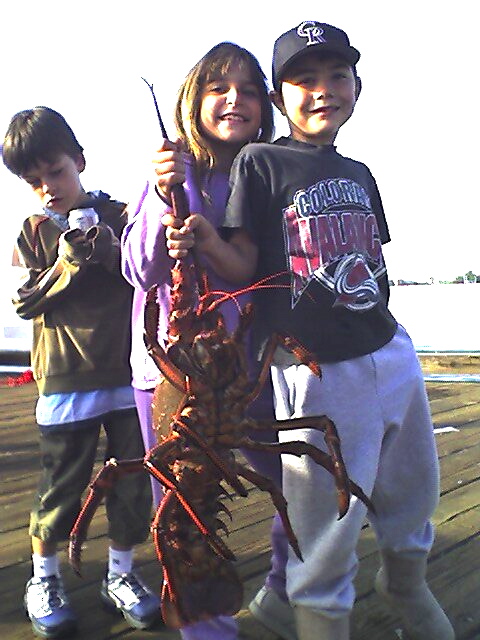
California spiny lobsters have been known to go as high as 25 to 30 pounds. Biologists figure a lobster that big could be anywhere from 50 to 150 years old.
“I have a friend who dives, and he’s saying it’s a minimum of 15 pounds,” Spencer said. “I wish now I would have taken it to a supermarket or somewhere and weighed it,”
Spencer and his boys celebrated the next day with a lobster feast. “You know how people say the big old lobsters are tough and not good eating,” Spencer said. “That’s not so. This lobster was tender and sweet. Really god eating.”
Looking back, Spencer said he likely would have quit around 9 p.m. had the boys chosen to go home to play video games. “It was all because they wanted to stay,” Spencer said. “It was our day out. And what a fantastic day.”
—Ed Zieralski, Outdoors, San Diego Union-Tribune, October 20, 2002
<*}}}}}}}}}>< — Fish surveys done by the California Department of Fish and Game between 2004 and 2009 give, I think, a somewhat fair representation of the species to be found at the pier. However, the 26 species do not include several species common to the pier. What’s missing, I think, are night surveys that would have shown an increased number of sharks and rays being caught. The species in the survey, listed numerically — Pacific sardine, Pacific bonito (all from one warm-water year), Pacific mackerel, queenfish, white croaker, topsmelt, walleye surfperch, jacksmelt, yellowfin croaker, barred surfperch, spotfin croaker, Mexican scad, salema, California corbina, shovelnose guitarfish, shiner perch, California halibut, white seabass, barred sand bass, sargo, jack mackerel, black croaker, California scorpionfish, halfmoon, California lizardfish and deepbody anchovy.
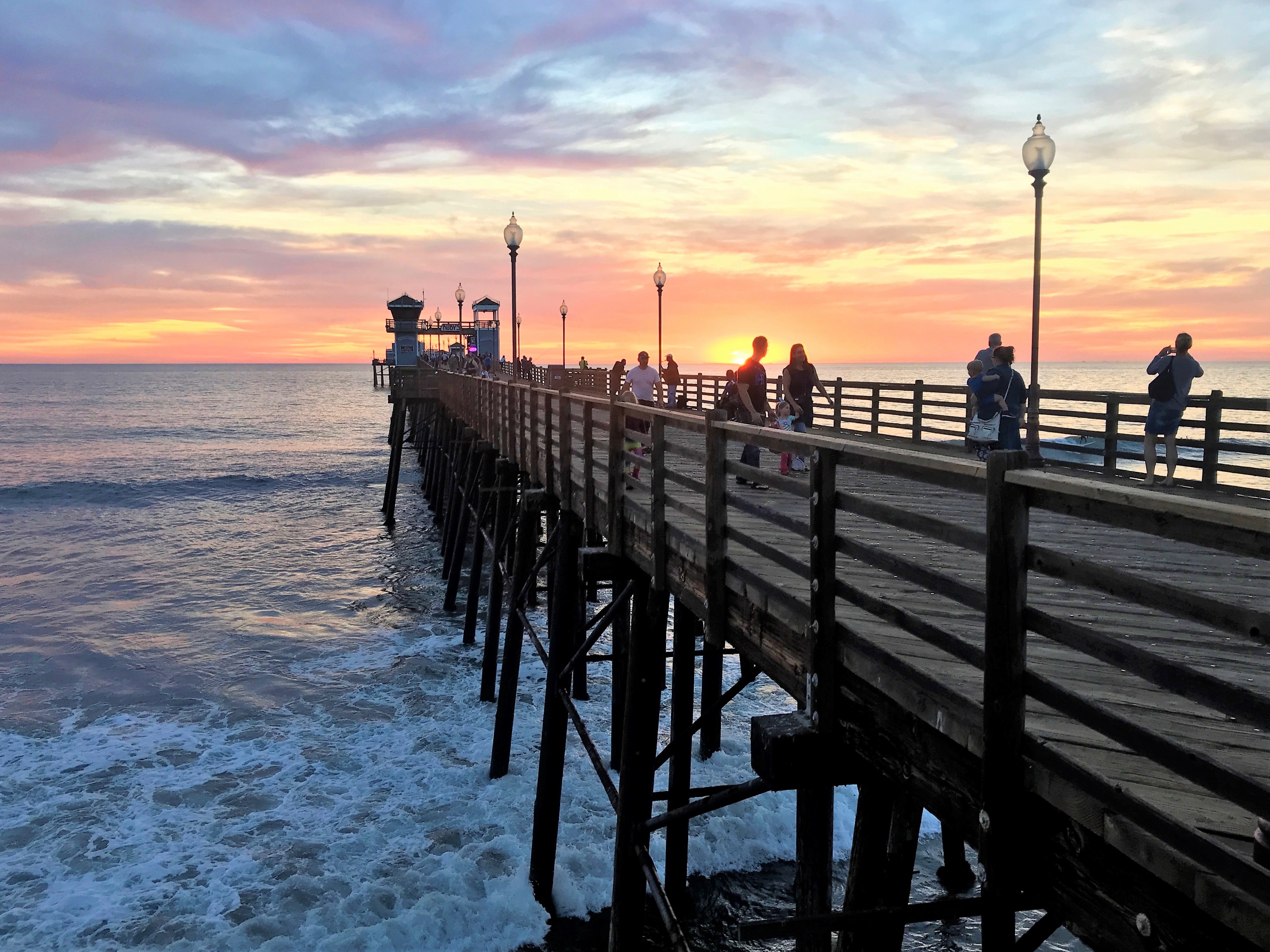
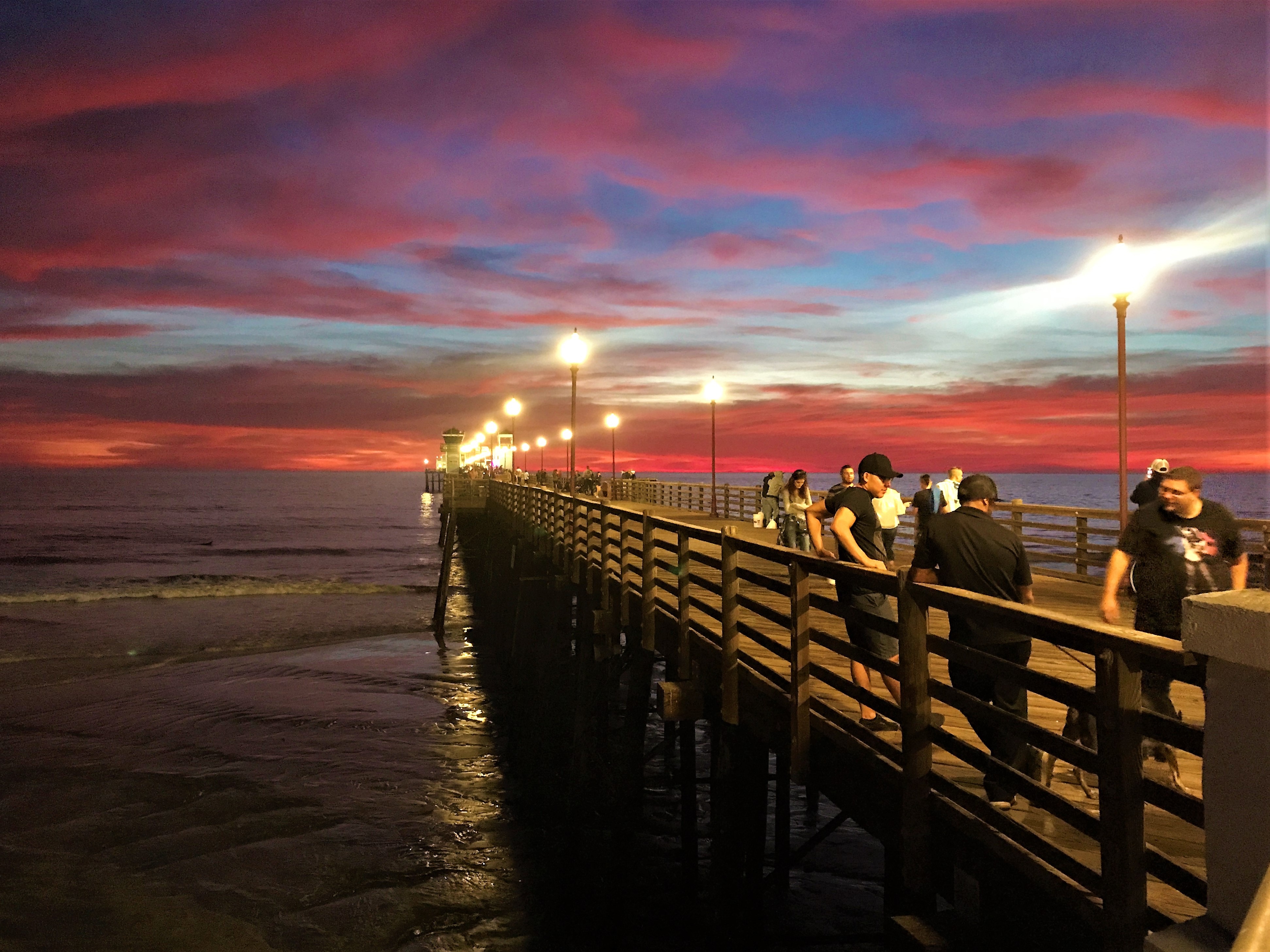
Pictures courtesy of my son Mike
<*}}}}}}}}}>< — At one time the Oceanside Pier had its own Sportfishing operation. One of the old pier items that I have is an unopened package with a wire barracuda leader. The printing on the package states it is from Art & Bill’s Tackle Store and says, “Save a Boat Ride—Drive to Oceanside. McCullah Bros. Sport Fishing, Oceanside Pier.” For reservations, one simply called Oceanside 4467. I’m not sure of the date of this package, it could have been anywhere from the thirties to the fifties. As for the McCullah Bros., they’re remembered fondly in the area.
THE WAY WE WERE — McCullahs changed face of Sportfishing
OCEANSIDE – Fifty-five years ago, two brothers from Newport Beach changed the future of local fishermen. Ray and Carl McCullah gave thousands of anglers new ways to fish in the Pacific when they brought two barges and several boats down the coast to Oceanside.
The McCullahs were known as two of the best fishing operators in Southern California, according to the Oceanside Daily Blade-Tribune, the local newspaper at the time. They signed a contract with Mayor Henry Witman and City Clerk John Landes, on behalf of the city of Oceanside, in January 1950.
Their company, McCullah Bros. Sport Fishing, began operating in April of that year from the Oceanside pier.
That’s where the adventure began, recalled Joel Hughes, 71, who owned the company from 1959 to 1965 with his stepfather, Ray McCullah, and his mother, Betty McCullah. The only way to board the boats, docked next to the pier, was to jump from the landing.
“You had to judge the swell. Some people found that very exciting,” said Hughes, who noted there was no harbor at Oceanside until 1963. Thousands of people came from all over Southern California to fish on the McCullahs’ boats. Visitors included Hollywood actors, such as Ray McDonald, Frank Ferguson and Lon Chaney, Hughes recalled.
“We had a following,” he said. “We made hundreds of close friends, many we’re still in touch with.”
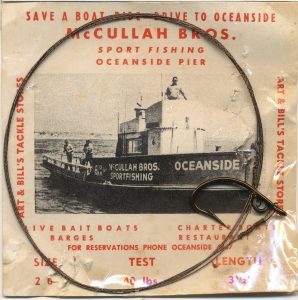
Some fishermen learned of the McCullahs’ operation through their motto, painted on the sides of their boats: “Save a boat ride – Drive to Oceanside. McCullah Bros. Sport Fishing, Oceanside Pier. For reservations call Oceanside 4467.”
The McCullahs and Hughes were at the pier every day, tending to their boats, bait and tackle shop and restaurant, which opened on the pier in 1951. They also hosted the popular Win, Place and Show Derby. An angler could bet $1 that he or she would catch the biggest fish, such as a 10-pound bass or a 25-pound yellowtail. When there wasn’t a winner, the derby’s pot continued to grow. Occasionally, an angler won thousands of dollars, Hughes said.
The community camaraderie built by the McCullahs was evident when disaster struck in April 1951. A storm damaged two boats and two barges from the brothers’ fleet, temporarily shutting down the sportfishing operation, according to a report in the Oceanside Daily Blade-Tribune.
As the McCullahs advocated the need for a harbor to prevent future disasters, the townspeople and clubs, such as the Lady Anglers, donated money. The business recovered and saw many changes during the following years, recalled Hughes, who lives in Carlsbad with his wife, Dorothy. The company moved to the small craft harbor in 1963 and was sold to Pierpoint Landing of Long Beach in 1965.
Yet some things never changed. “When there’s a lot of fish, there’s no bait. When there’s a lot of bait, there’s no fish,” Hughes said.
— Amy Horton, San Diego Union-Tribune, July 17, 2005
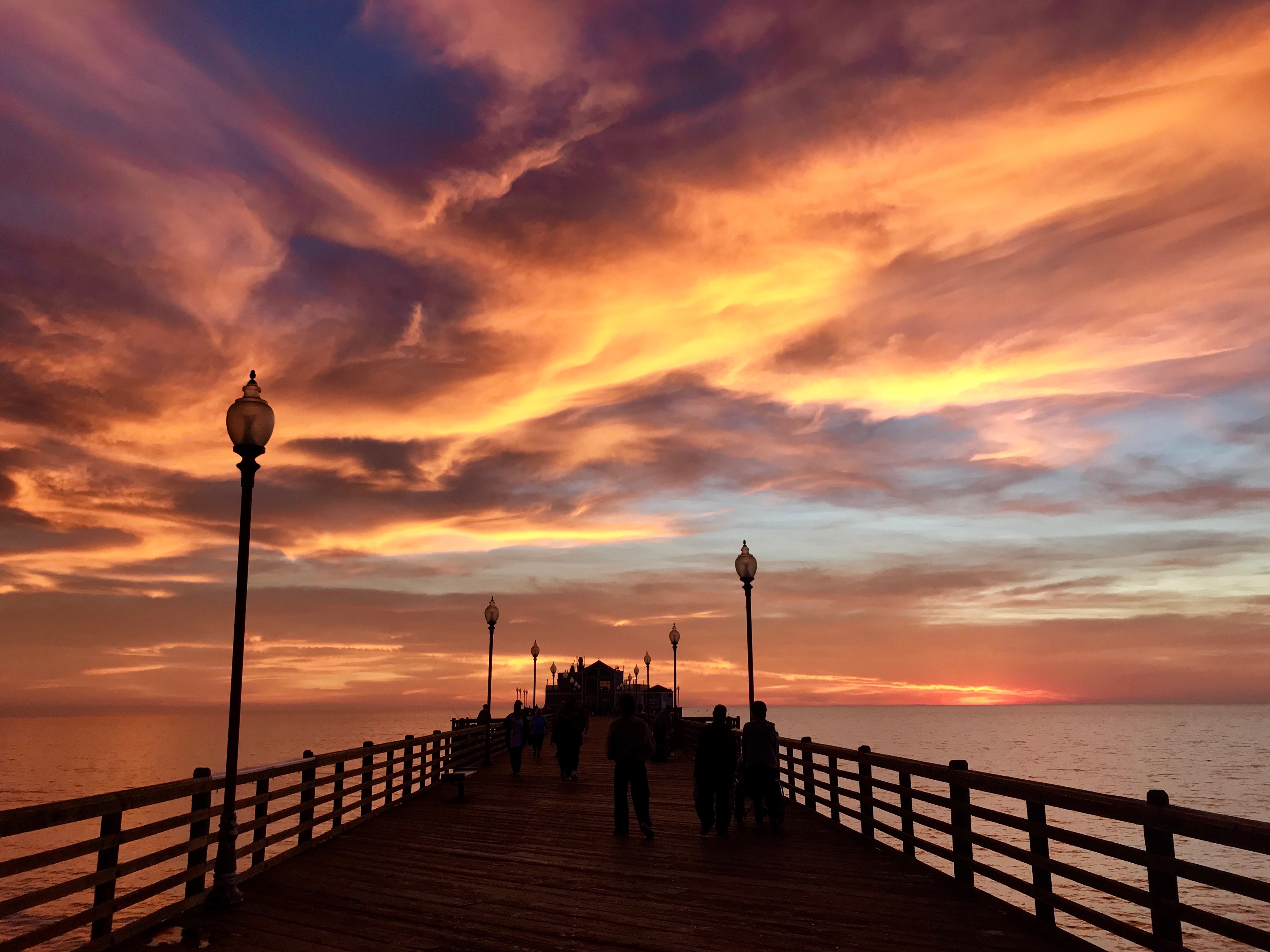
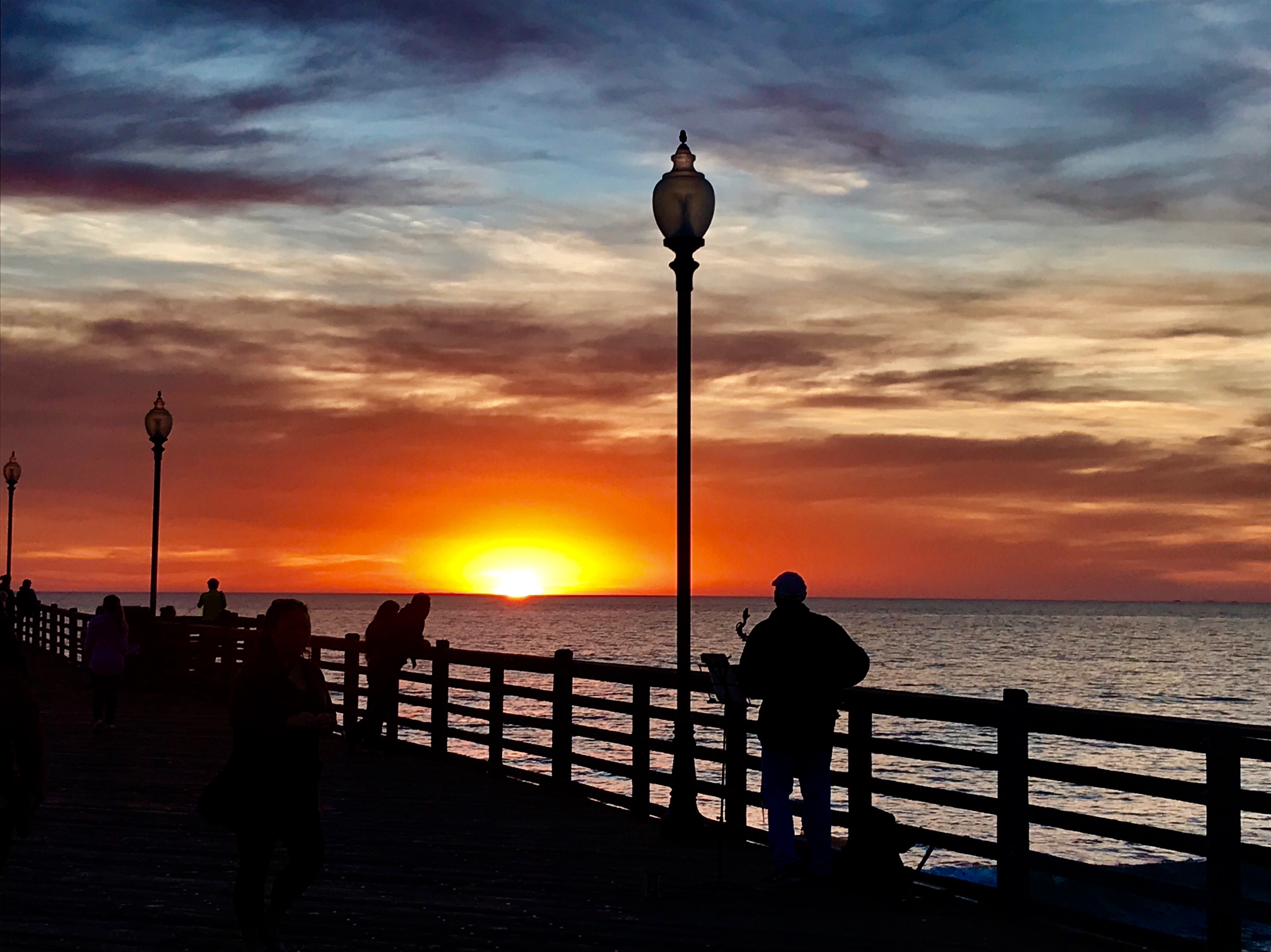
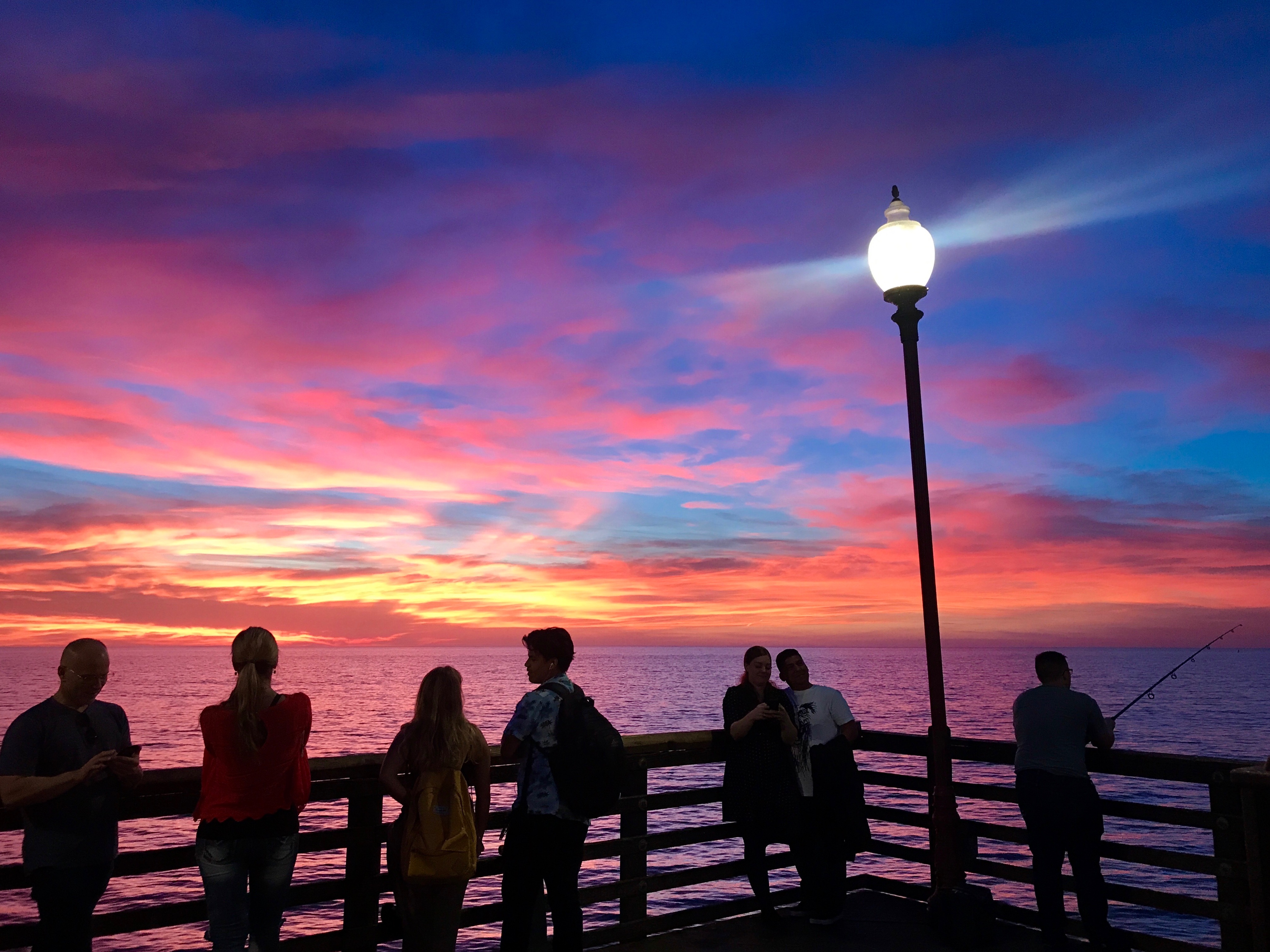
Pictures courtesy of my son Mike
<*}}}}}}}}}>< — Sounds like “The Emperor’s New Clothes” or “The Boy Who Cried Wolf.” And anyway, who ever heard of a fisherman telling whoppers?
Life Dream of Fisherman Who Almost Gave Up Hope but Didn’t
A year ago Charles (Chuck) Martin of Oceanside was reveling in his fame as a teller of fish stories. Now Chuck is bemoaning that same reputation. He says that once a fellow gets a reputation for telling whoppers no-body will believe he’s in earnest, even when he says it’s a nice day.
Among the fishermen well known on the Oceanside Pier is a gentleman who for years has been spending his summers in Oceanside. He comes from an inland town, and the dream of his life has been to catch a huge sea fish. Of course, there are places where one may be photographed with stock, stuffed fish, but that fisherman was too high-minded for such tricks. Summer after summer he returned to Oceanside, cherishing a secret hunch that the moment of achievement was at hand. But each autumn, as he sadly packed up to go home, he had to sigh and say: “Next year—maybe.”
So his eight-second anniversary arrived, and his dream was no nearer realization than it had been when he was a boy of 60.
He was no deep-sea fisherman. From a barge or from a sea-going launch he might have caught a big fish. Be he was a landlubber who would not venture farther from terra firma than the end of the Oceanside Pier. There he could feel that he was only knee deep in the ocean, and when a big wave burst on the knees of the pier with an ardor which made it tremble he could rejoice in the knowledge that its thousand sturdy legs were braced in solid earth.
He had about given up his lifetime dream. But it was something to be fishing at 82, so he went out again to celebrate his birthday. He went to the extreme end of the pier and let out enough line to carry his hook out beyond competition. And then suddenly he pole began to bend like a reed in a tornado.
He seized it with a shout. For a moment it looked as if he would either have to let go or be carried off the pier. But he hadn’t been fishing for thirty years for nothing. He knew how to play a fish. Other fishermen rushed to his assistance, but he waved them away—with his head, for his hands were busy. And at last he landed his prize—a jewfish weighing 202 pounds.
Chuck Martin was inspired. Of course he wrote the event up for the Oceanside Blade-Tribune. But all the readers of that excellent paper remembered Chuck’s series of “whoppers” and thought it was just one more. So he wrote a magazine story about it. But what chance has a man who has written a whole book of whoppers when he tries to write a true story? It was the impossibility of all Chuck’s whoppers which made them amusing. So the editors sent it back. “Are you losing your imagination?” they wrote. “This isn’t nearly as preposterous as the stories you’ve given us before.
Then Chuck accompanied his story with photographs of his elderly friend and the fish, towering half a head taller. But the editors knew that on the Long Beach pier there is, or used to be, a place where one could be photographed with stock fish which, before they were stuffed, weighed a ton or more.
So Chuck has a darned good fish story on his hands—one with a lot of real heart interest in it—perhaps the best fish story he ever wrote. And he can’t do anything with it because he has too good a reputation for whoppers.
—The Leeside o’ L. A. by Lee Shippley, Los Angeles Times, August 24, 1934
Did You Know? Two major surf competitions take place adjacent to the pier in June—the West Coast Pro-Am and the National Scholastic Surf Association—and parking can be pretty gnarly. If you plan to fish the per on those weekends (check the newspapers for dates) get there early.
Did You Know? The Oceanside Pier is seen in the movie Bring It On? Or that it is seen regularly in the television series “Animal Kingdom?” My son has worked as an extra on several of the episodes which gives him a chance to be in Oceanside and to take the pictures attributed to him.
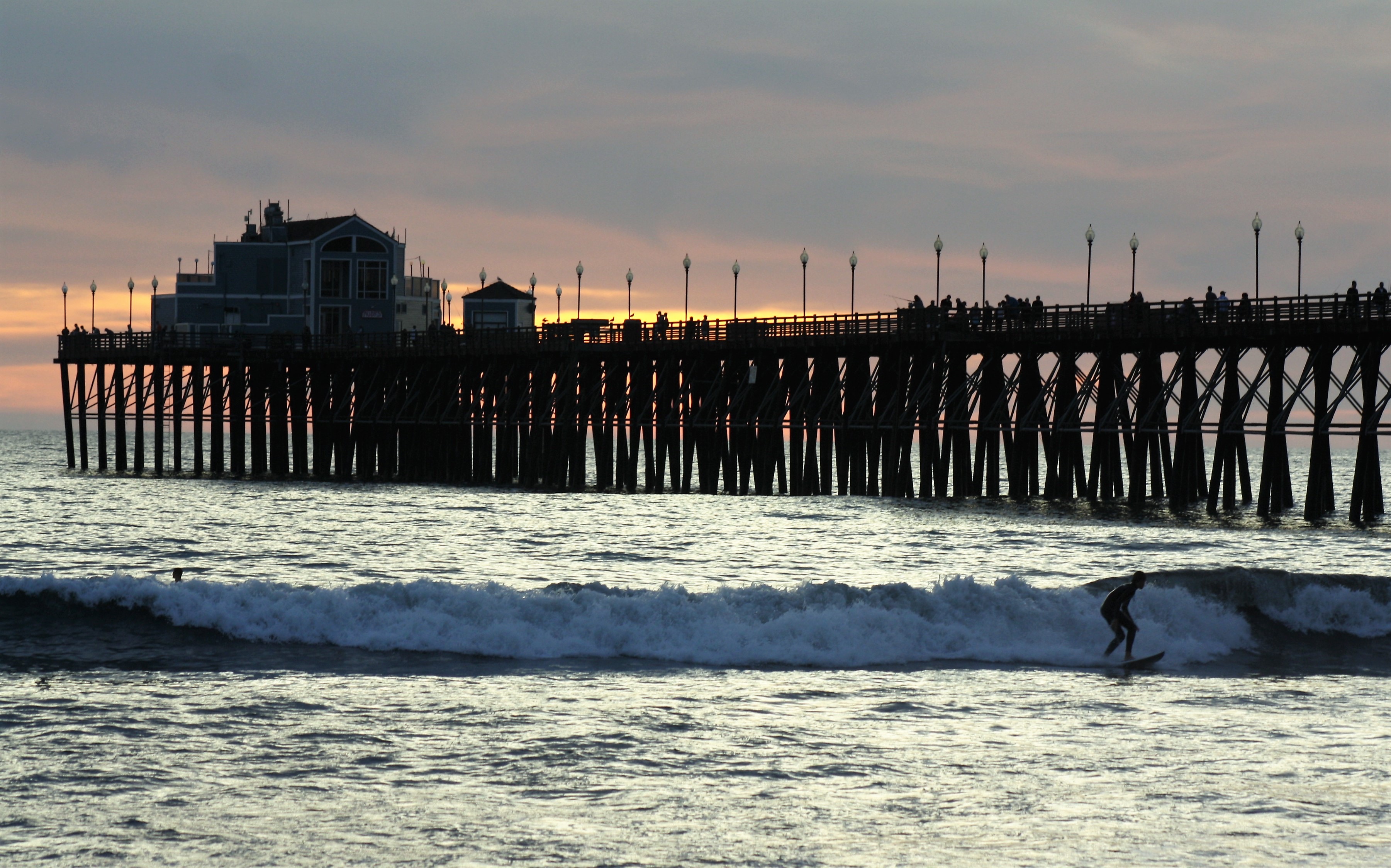
Picture taken by son Mike
Oceanside Pier Facts
Hours: Open 24 hours a day.
Facilities: A parking lot is available near the entrance to the pier and metered parking is available on Pacific Street. Restrooms and the Oceanside Pier Bait & Tackle shop are located mid-pier. Lights, benches, and fish cleaning stations are found throughout the pier. Snacks can be purchased at the bait and tackle shop while a Ruby’s Diner with its ‘50s themed food and servers covers much of the end of the pier.
Attractions: The Junior Seau Pier Amphitheatre and Junior Seau Beach Community Center (Beach Recreation Center) are located near the front of the pier. The amphitheater hosts a plethora of events while the recreation center includes a gymnasium, stage and kitchen. Not too far from the pier (312 Pier View Way) is the California Surf Museum, a neat place to visit if you’ve ever had a question about surfing. The cost is $3 adults, $1 students/seniors/military. Two events that start near the pier and can lead to virtually no parking being available are: (1) the Beach Soccer Championship, the largest on the west coast. It takes place the first weekend after Mother’s day in May; (2) Race Across America. Annually held in the second week in June, the 3,000-mile bicycle race is considered the world’s toughest sporting event. Many other events are also held on the beach and pier and give reason why this is one of the most visited piers in the state.
Handicapped Facilities: The pier hashandicapped parking and restrooms. The pier surface is cement and planking and the rail height is 44 inches. Posted for handicapped.
Location: 33.19278 N. Latitude, 117.38583 W. Longitude
How To Get There: From I-5 take Mission Blvd. west to Pacific, turn right and follow it to the pier.
Management: City of Oceanside, Public Works Department.
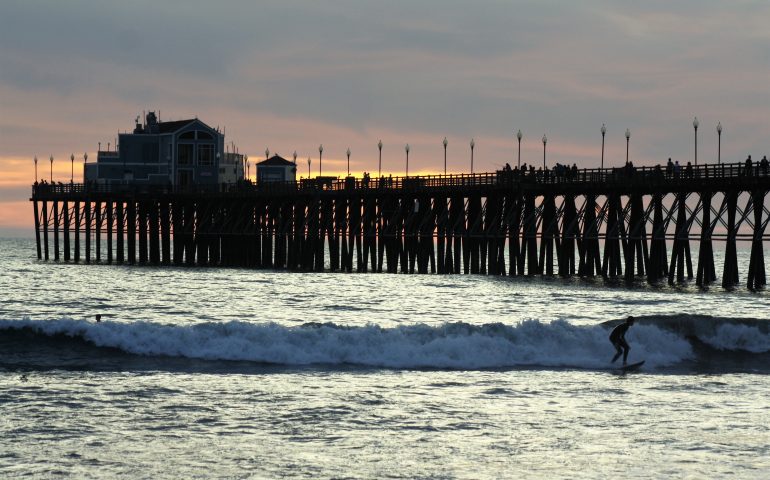
Always enjoy reading your articles Mr. Jones. I’ve been visiting Oceanside pier for close to 40
years, and enjoy your guide book for many years. Enjoyed some quiet fishing after midnight fishing
there– it’s too crowded at daytime! I had no idea that there was a proposal to close it down at night!
Yes, you’re right– it’s not a cheap place to visit anymore, but it’s still beautiful! Thank you very much,
and good fishing! With respects– Haik Goomroyan from Las Vegas.
Haik, Thank you for your kind comments. Ken
My barber was talking about betting on sports the other day. Thought I’d look for a site with a cool aviation game instead. Checked out site and it’s solid. From Nigeria, it’s got this Aviator game that’s a blast, with other casino stuff and bonuses like free tries or extra cash when you join – easy to play, all Nigerian. Felt like a fun twist on his stories.
I really liked the historical facts and fishing tips for different seasons. This is not just a pier, but a whole cultural space with its own energy and community.
And if you value unforgettable impressions not only from nature but also from travelling in comfort, I recommend paying attention to renting a Porsche in Dubai. Such a trip gives no less emotions than the sunrise at Oceanside Pier.